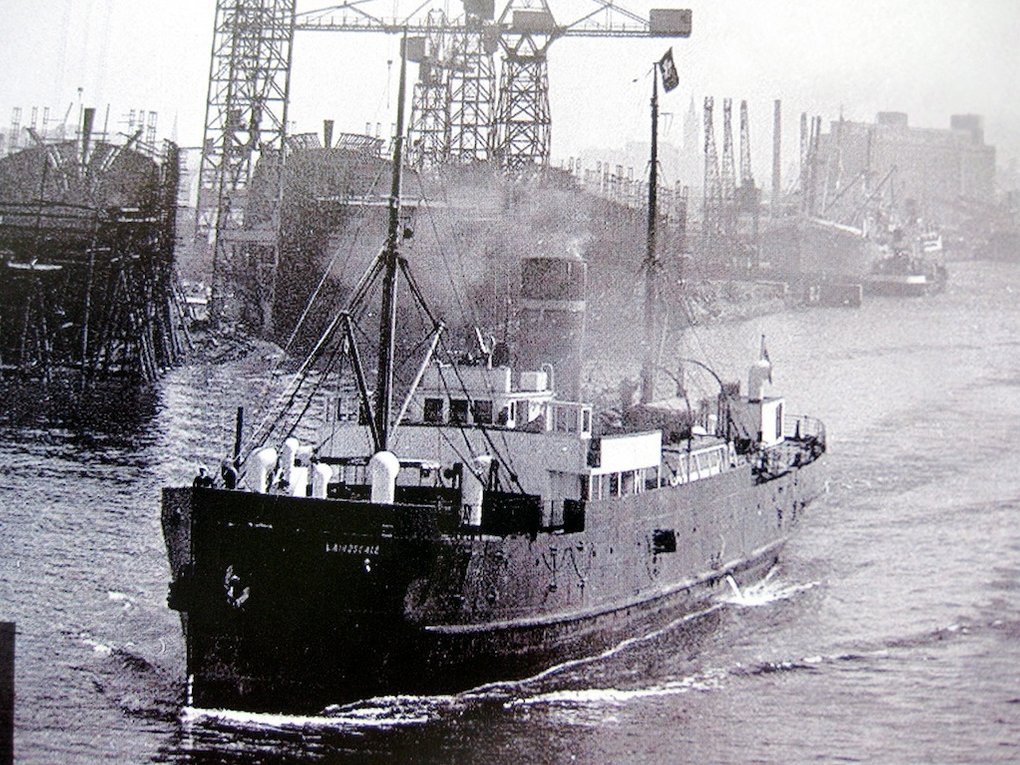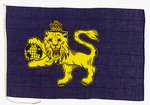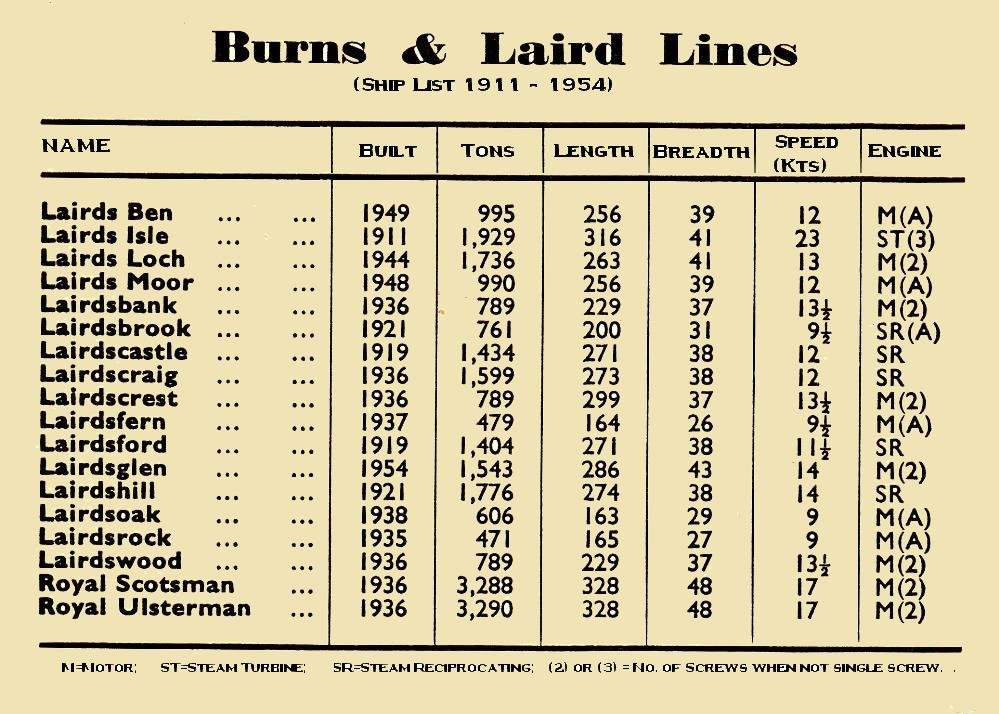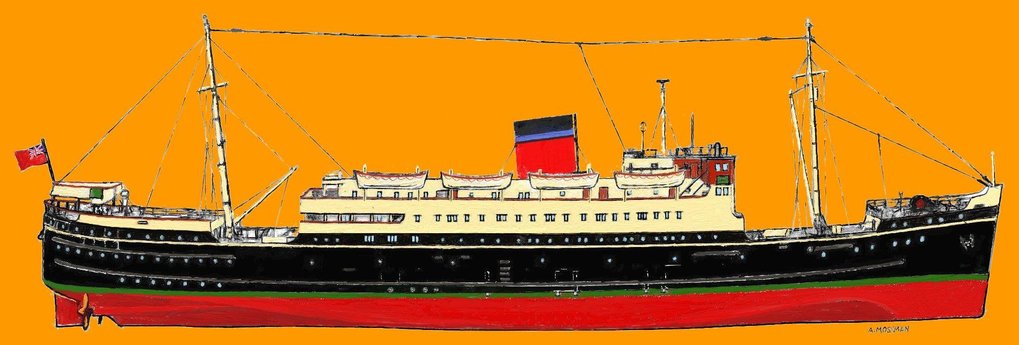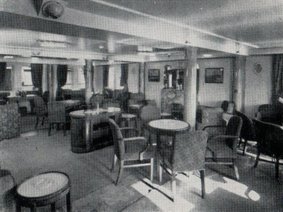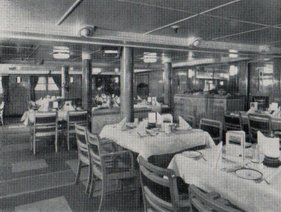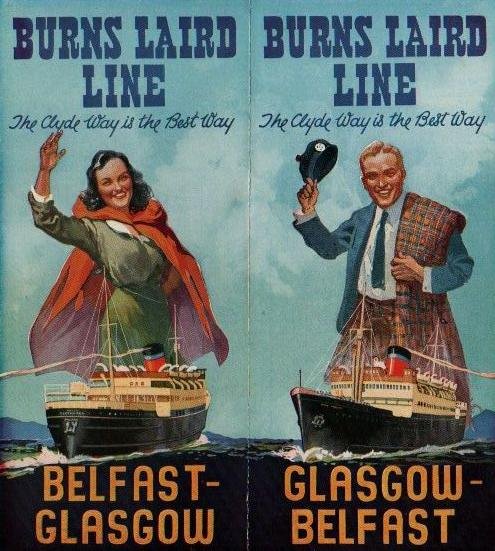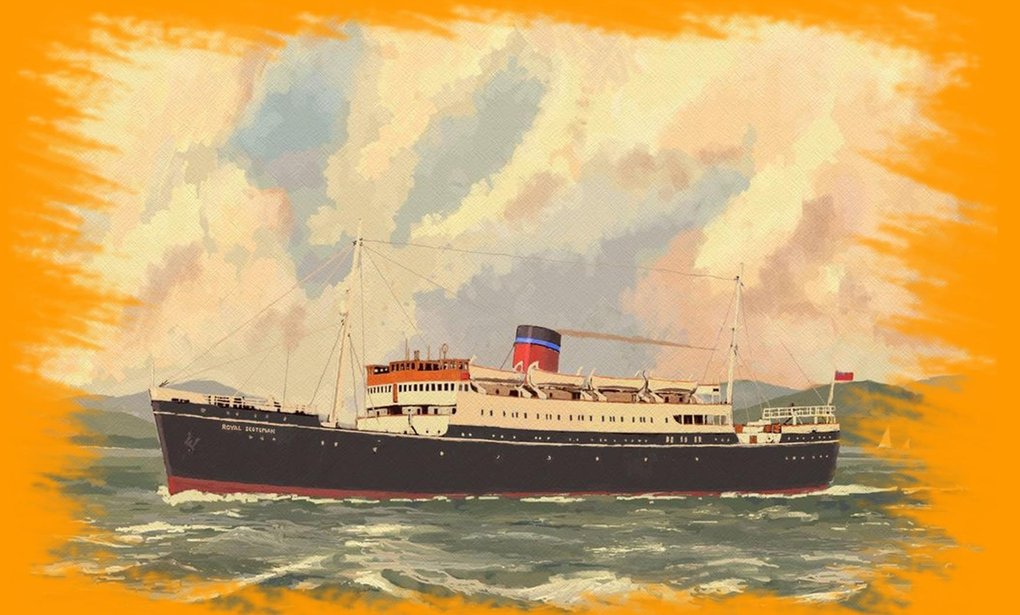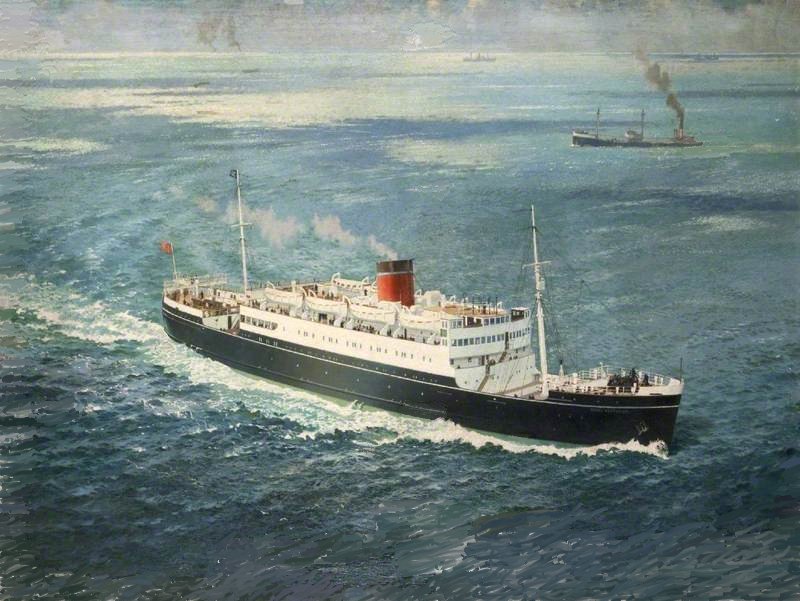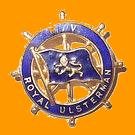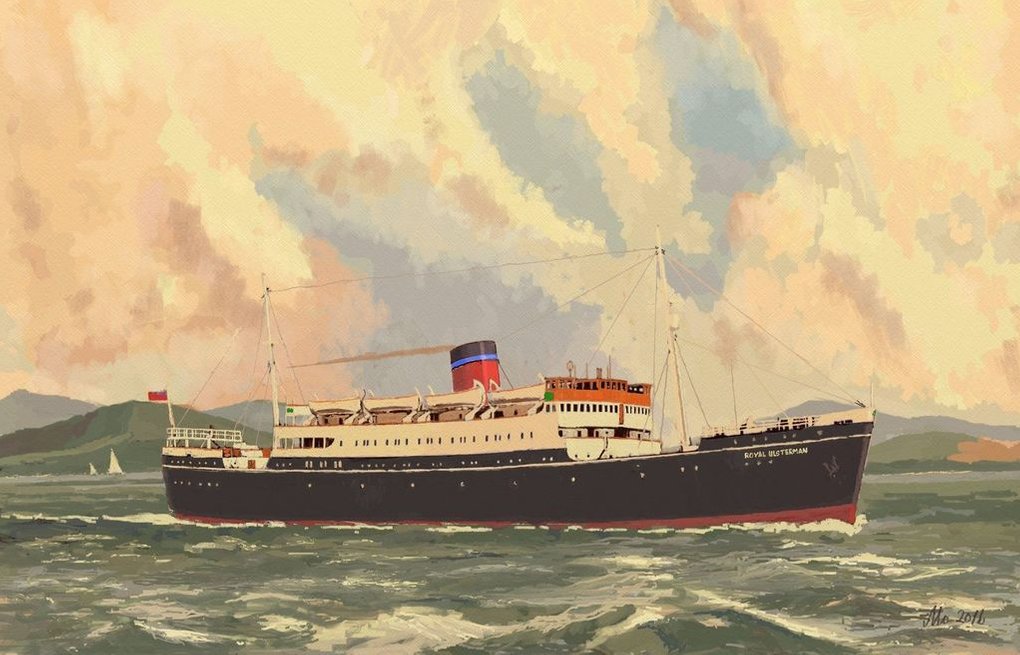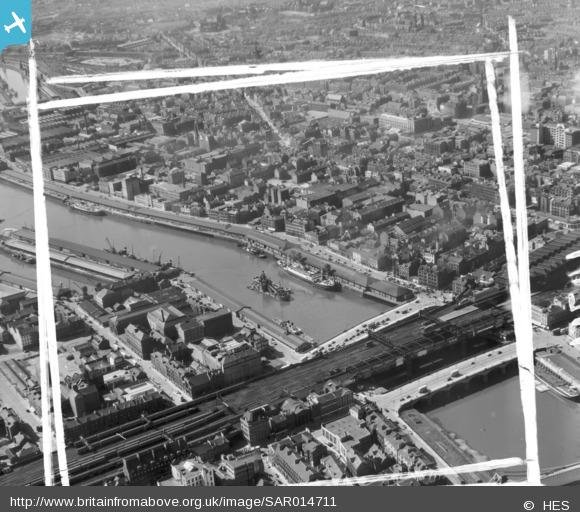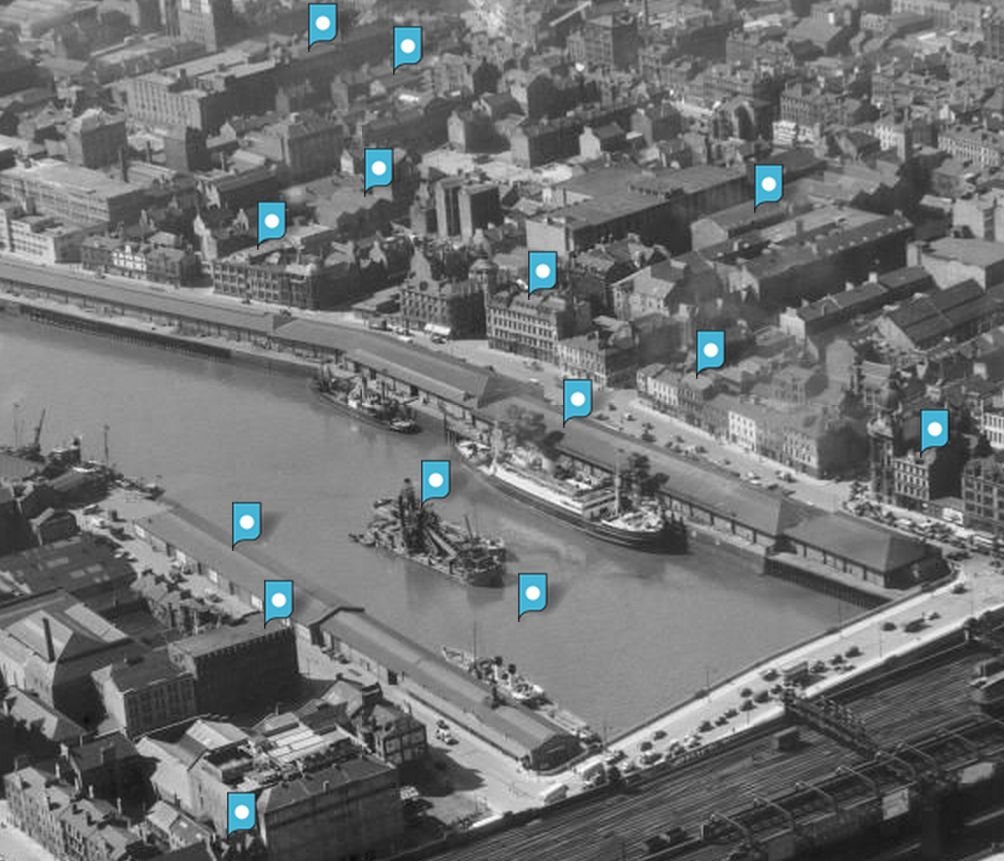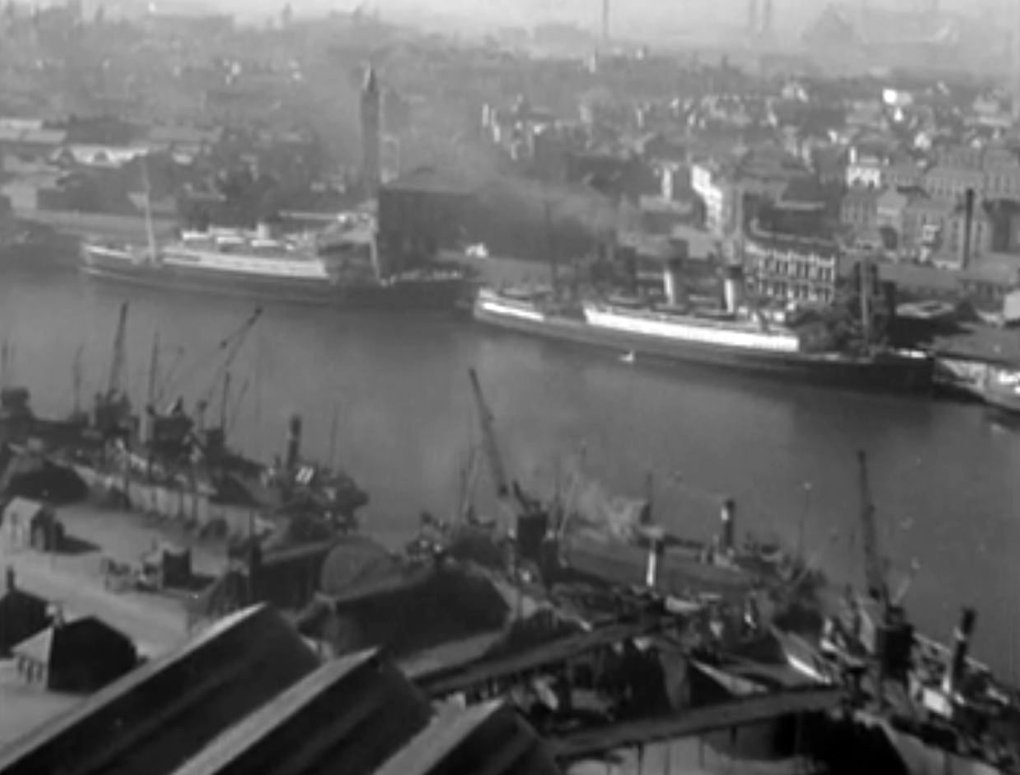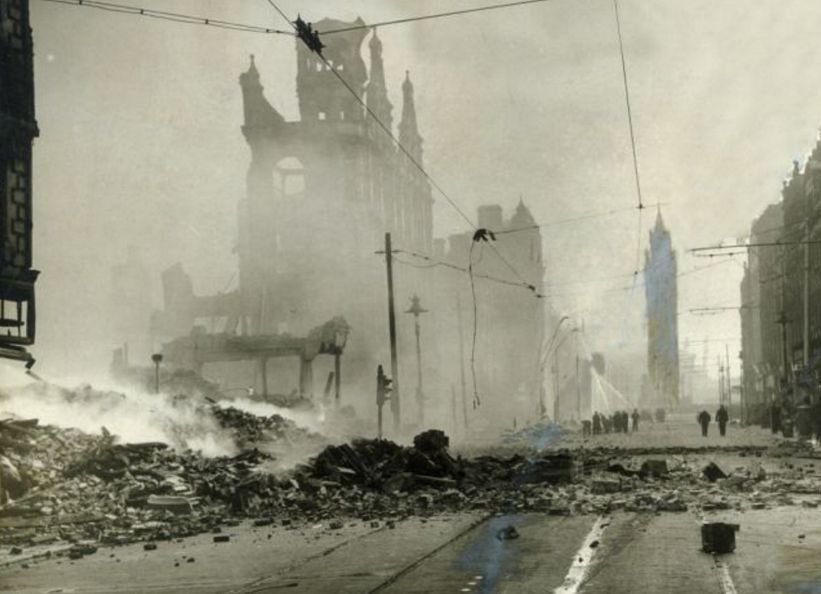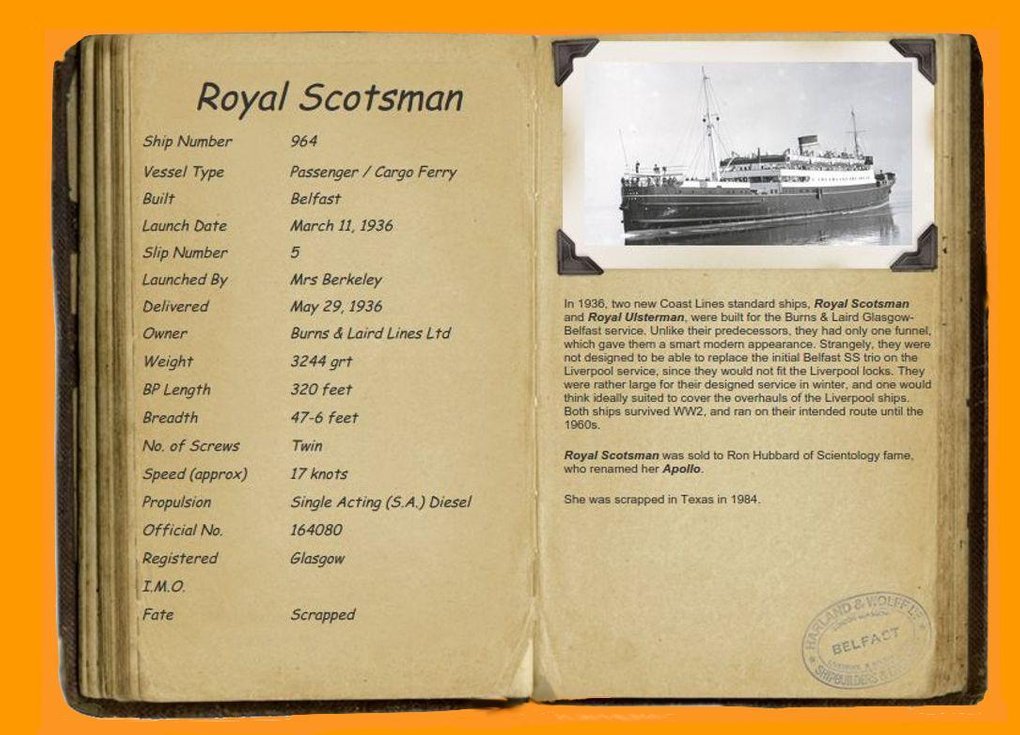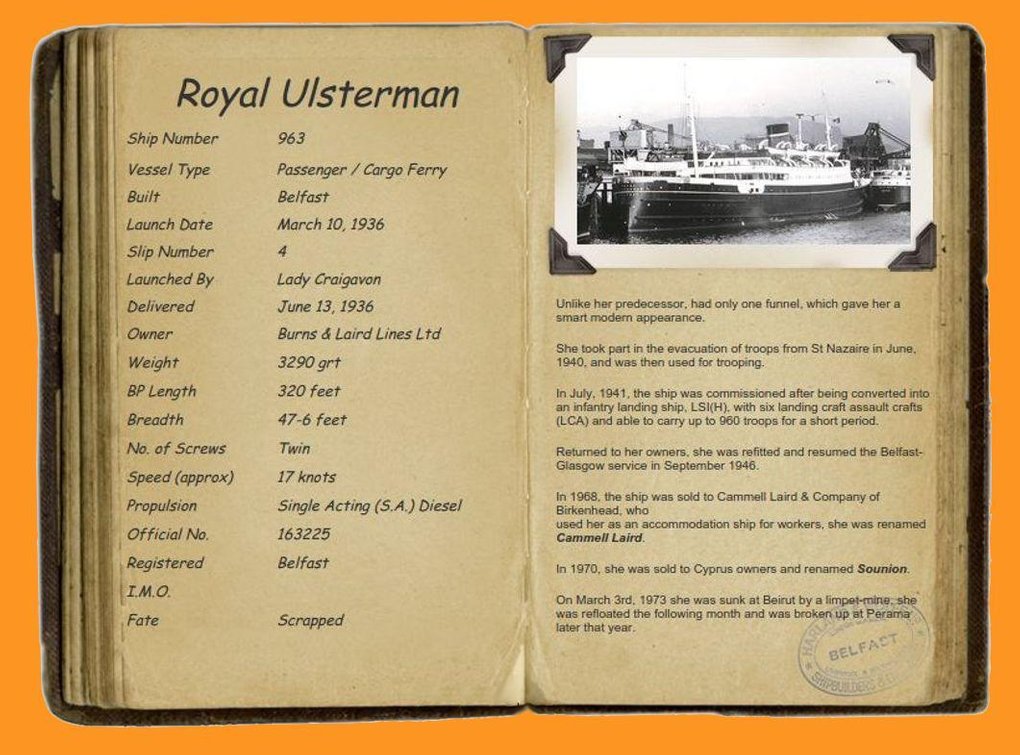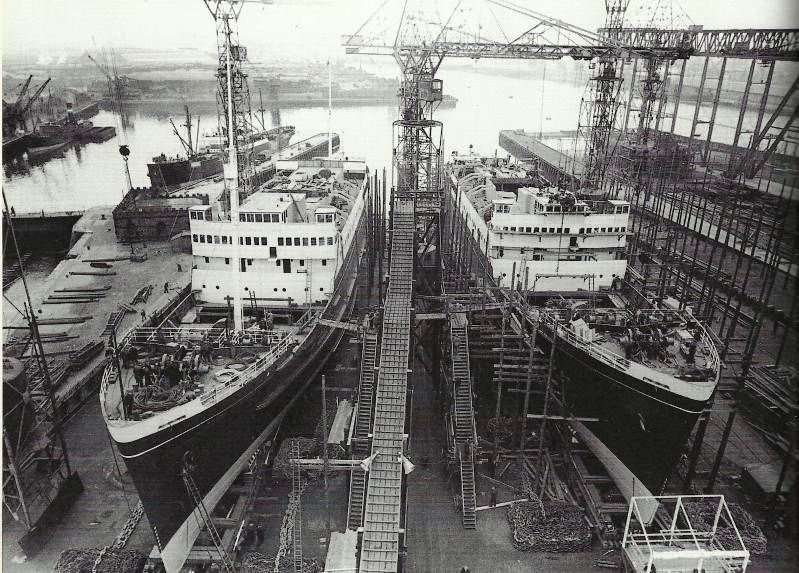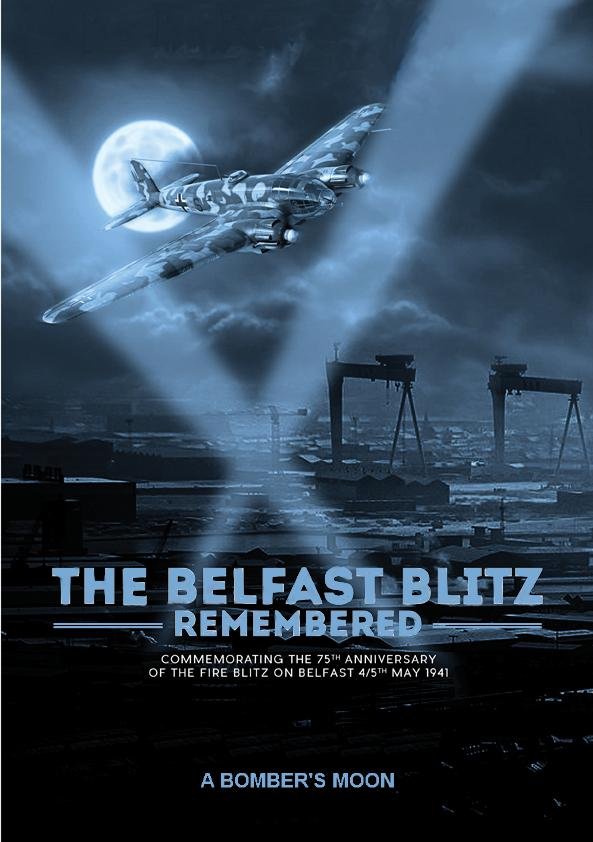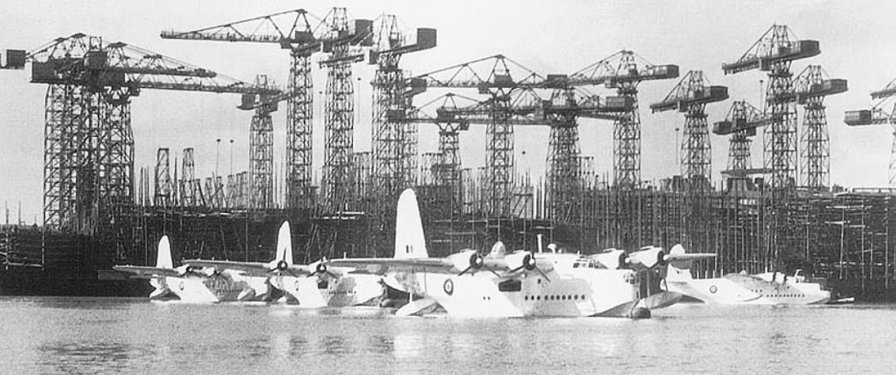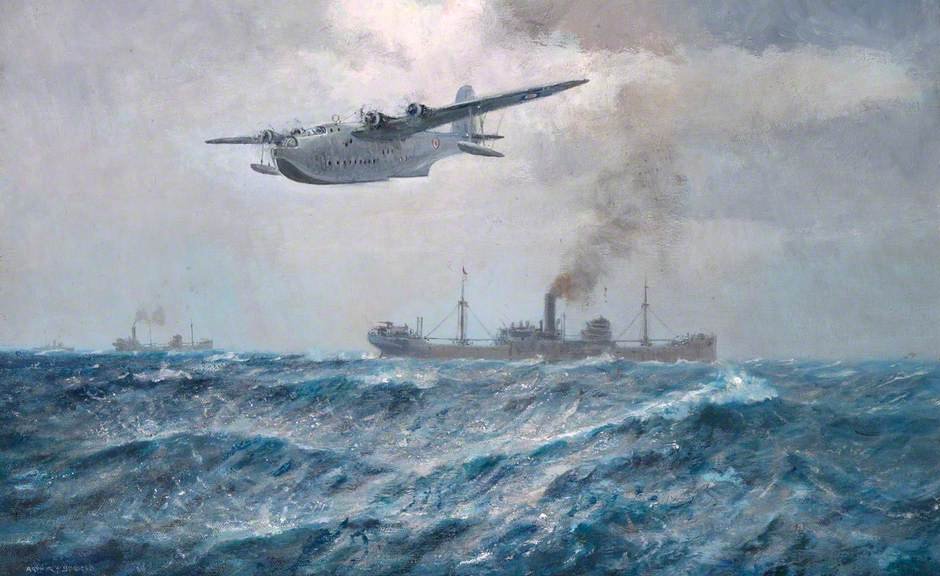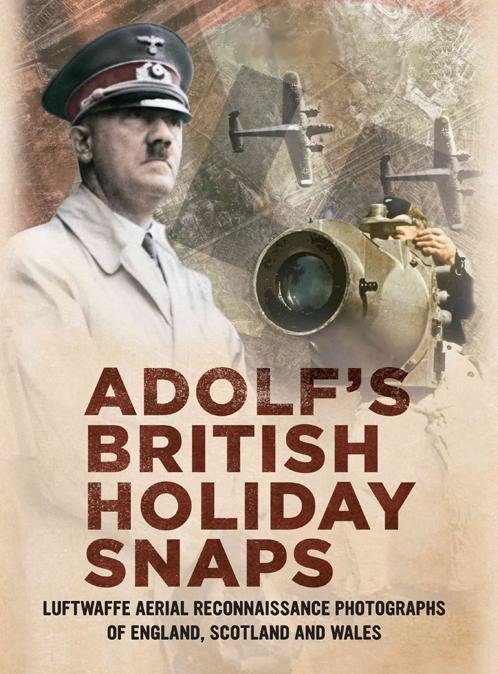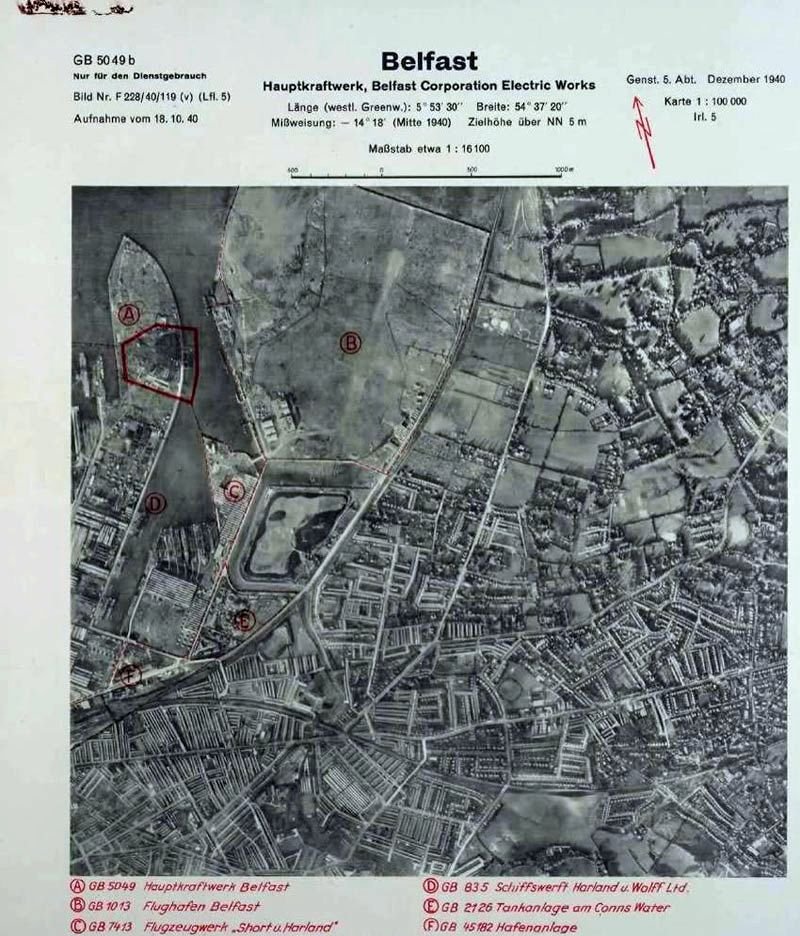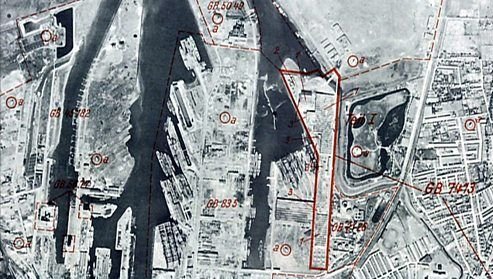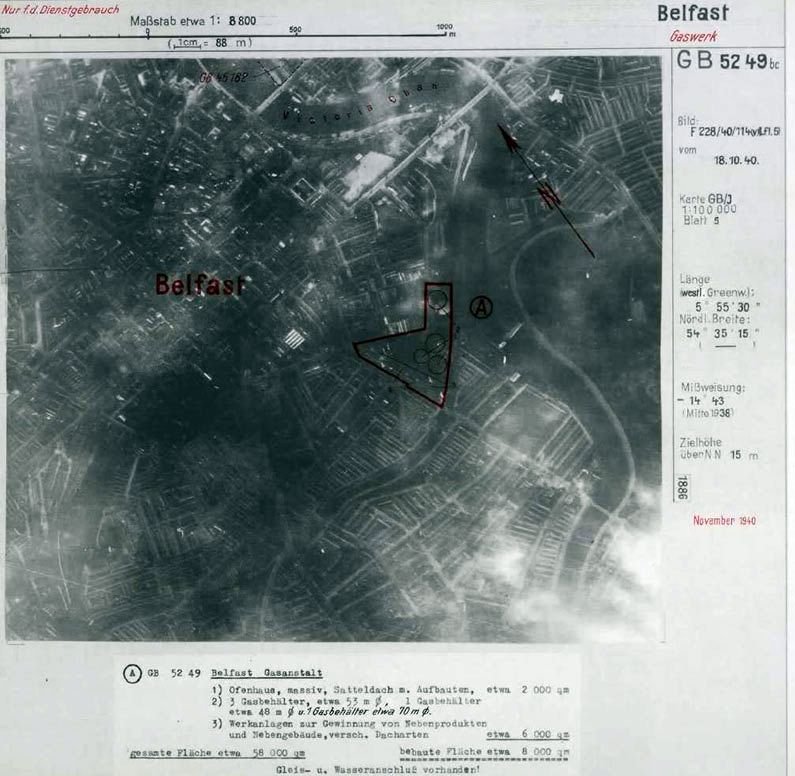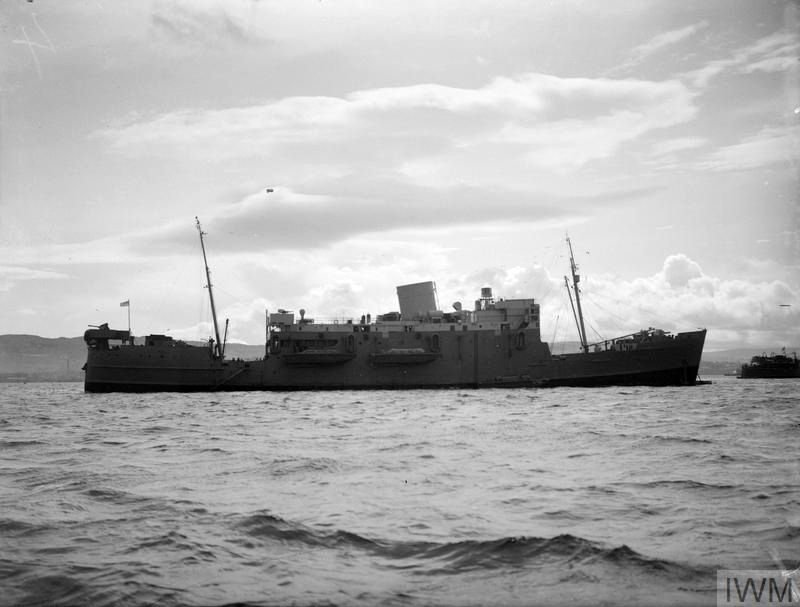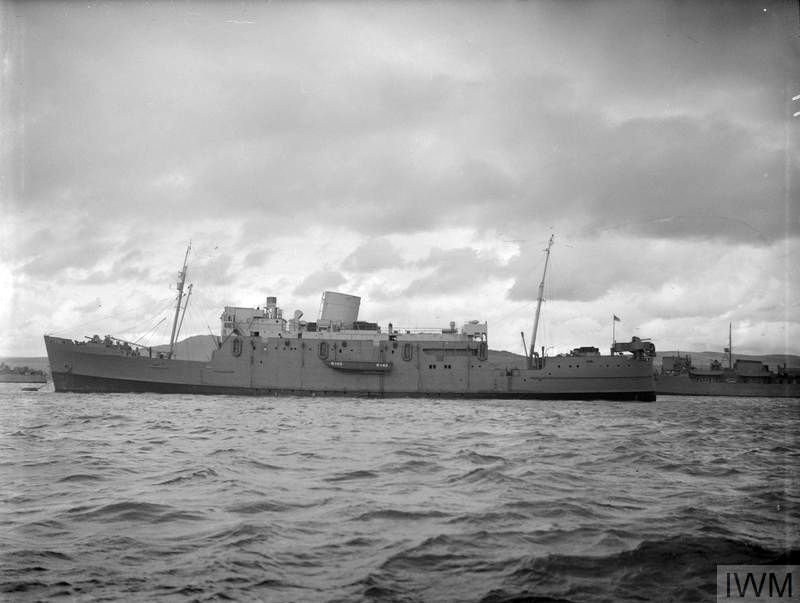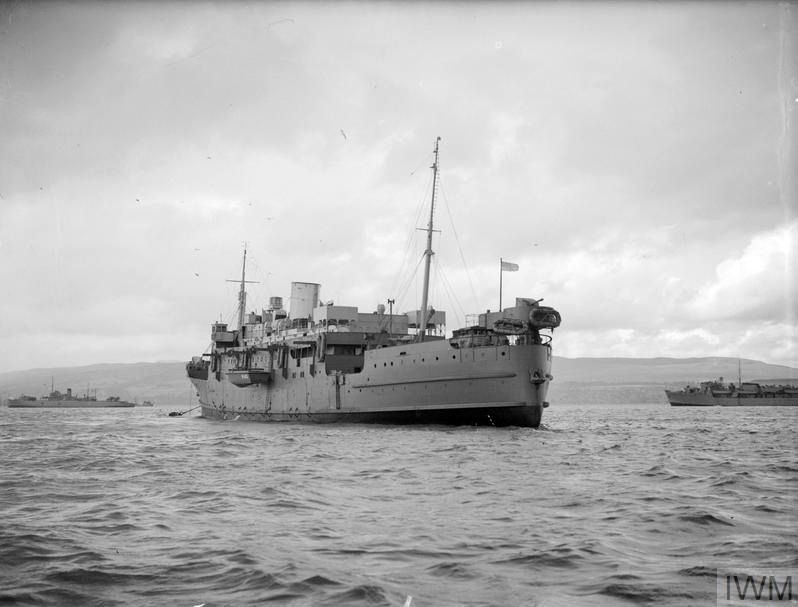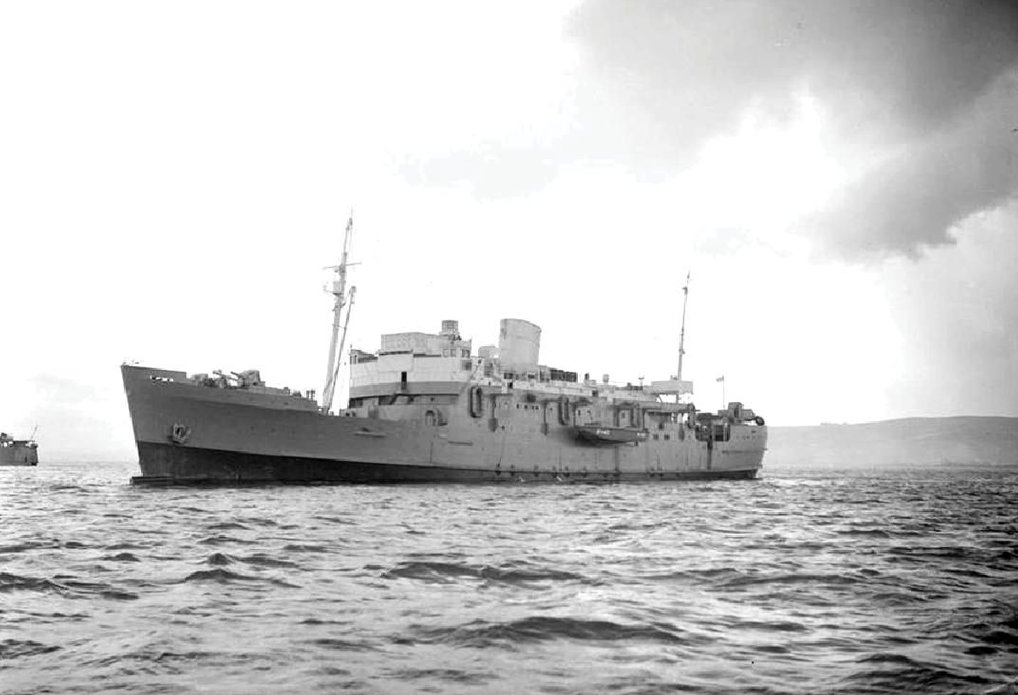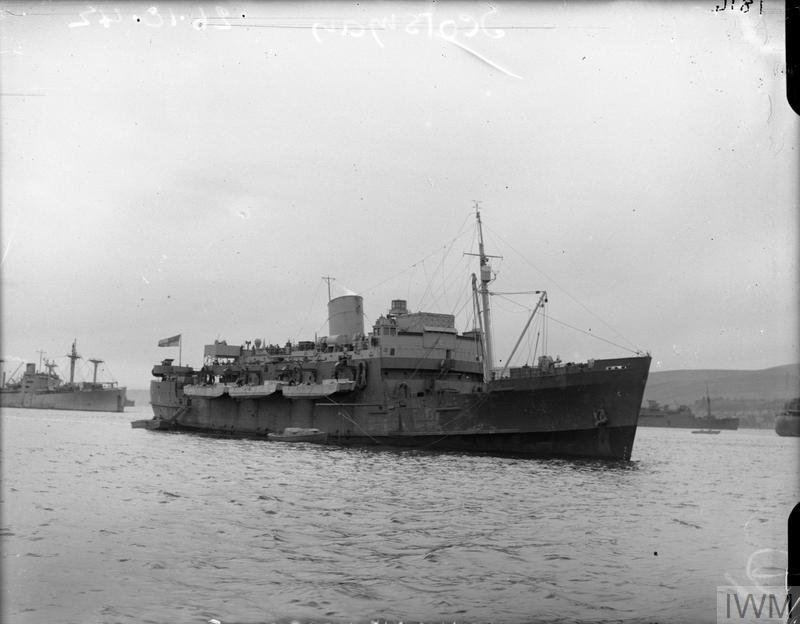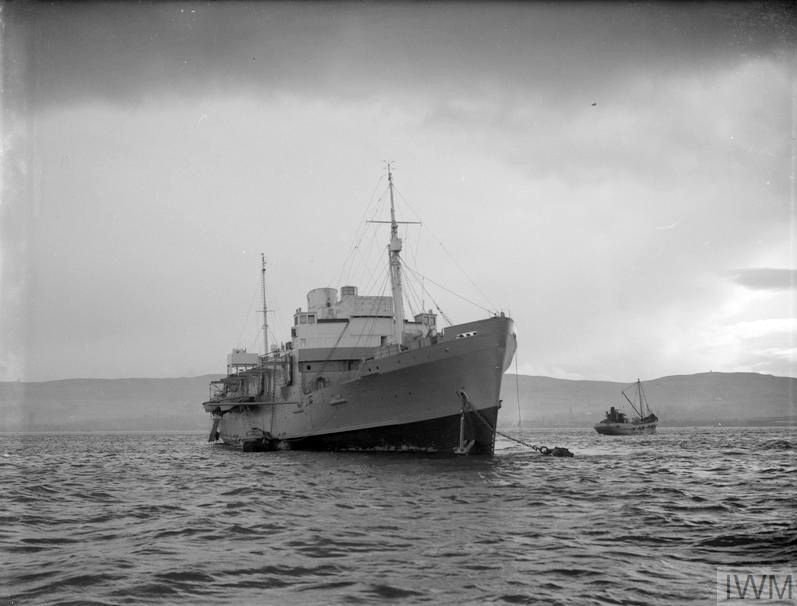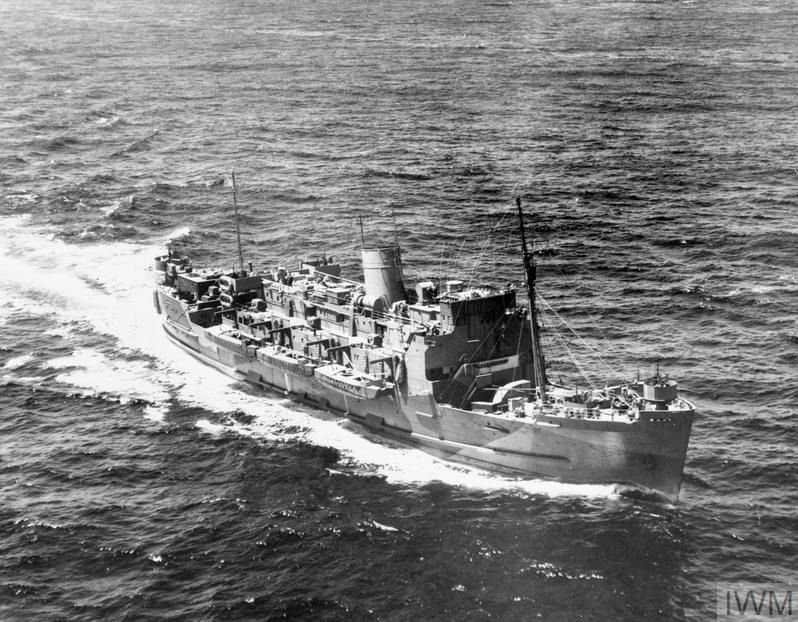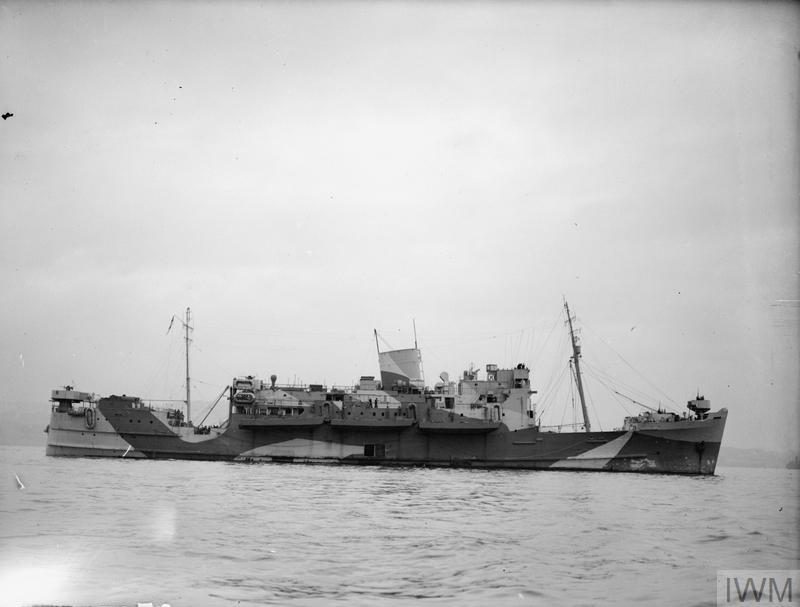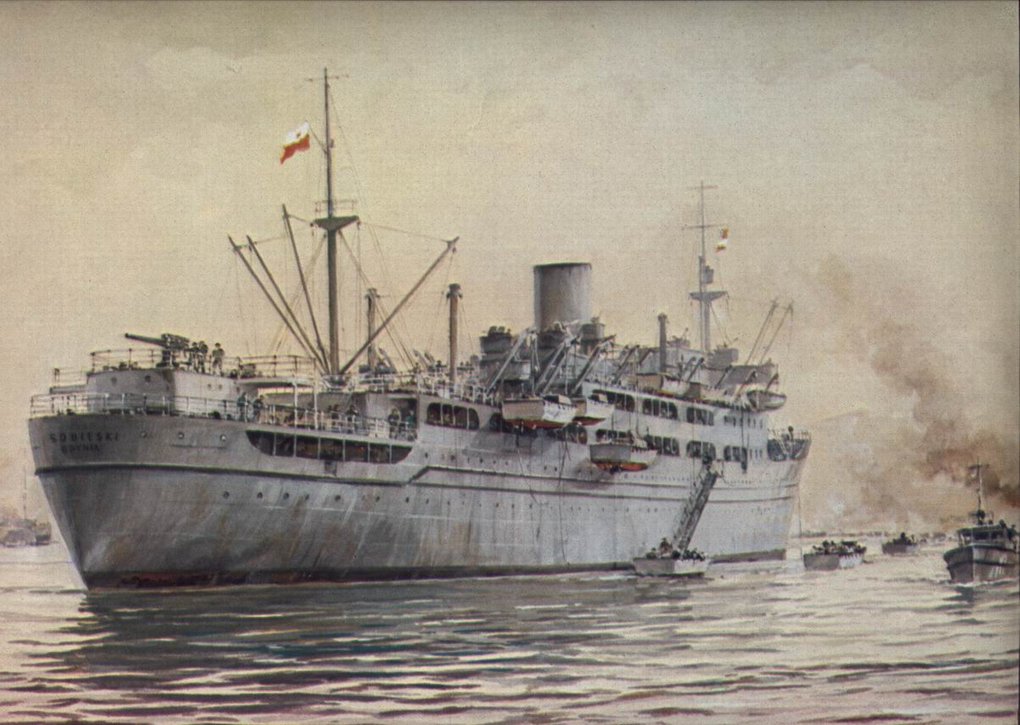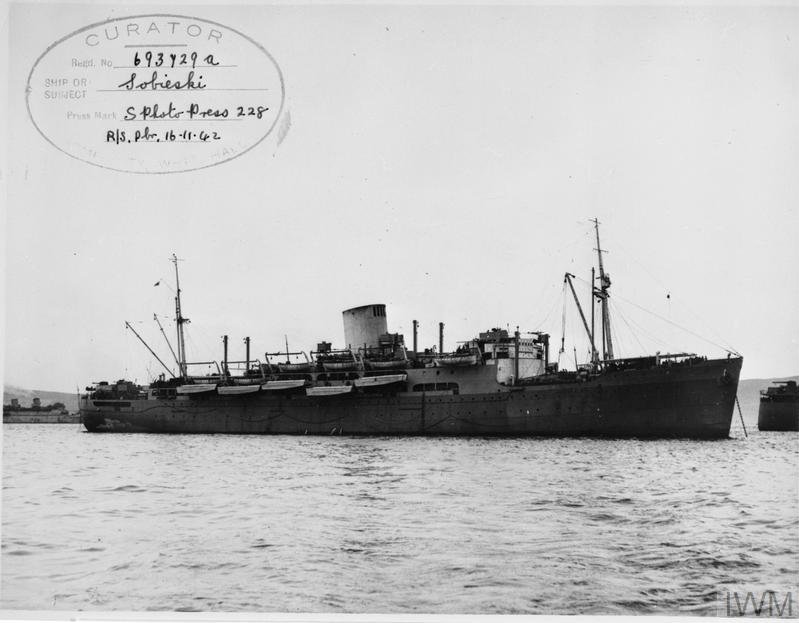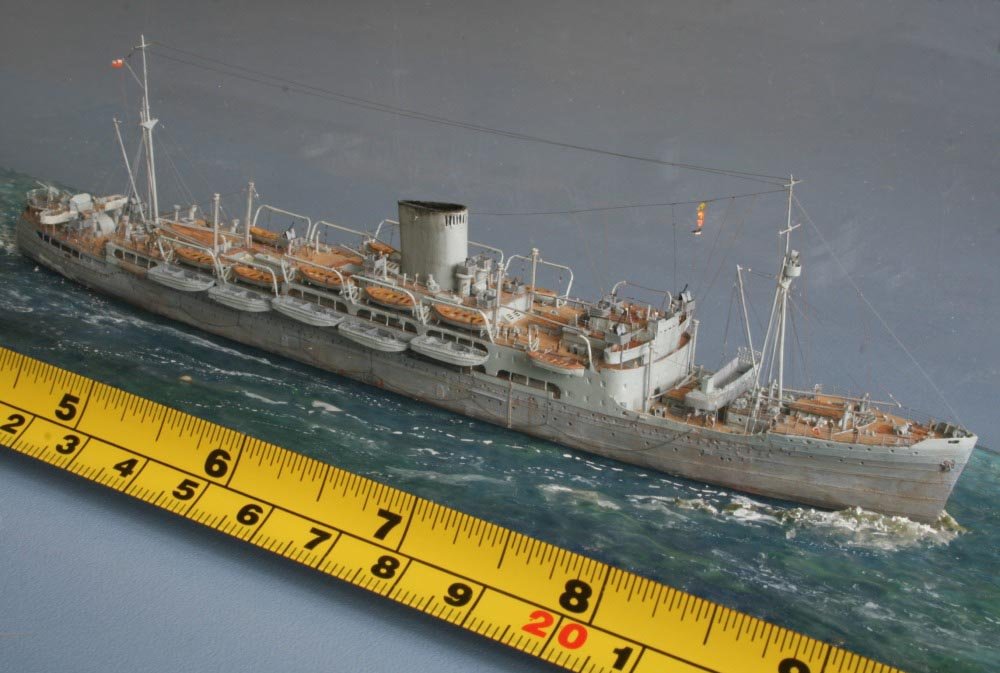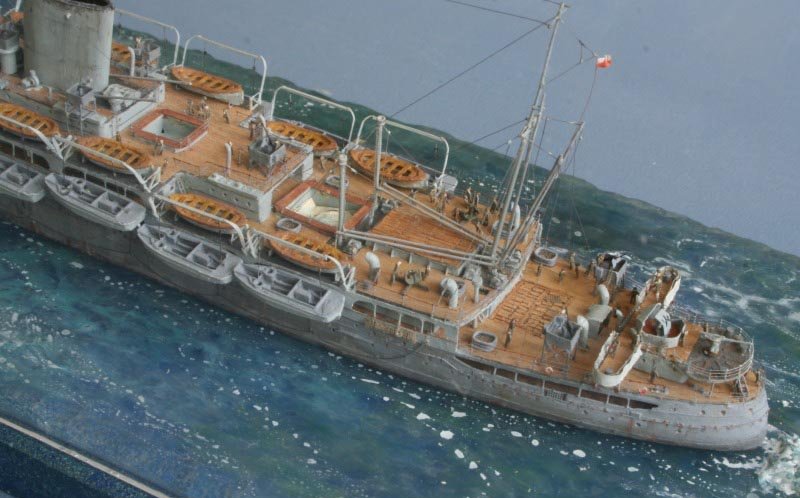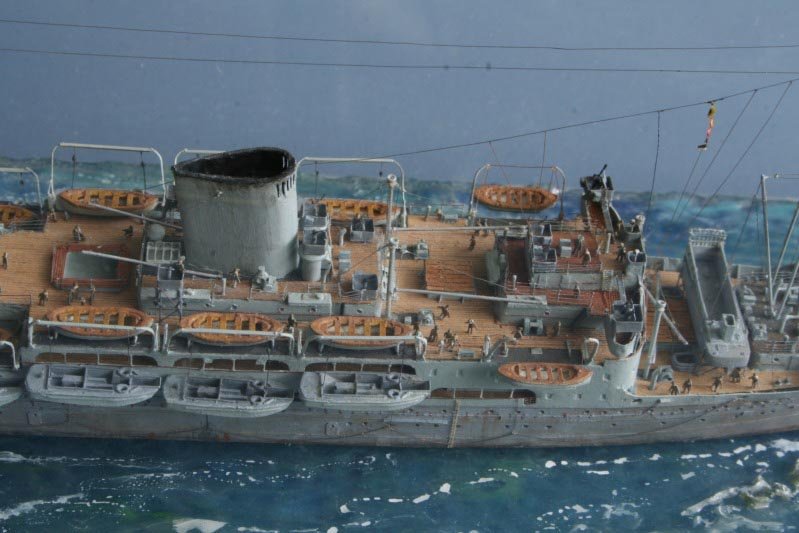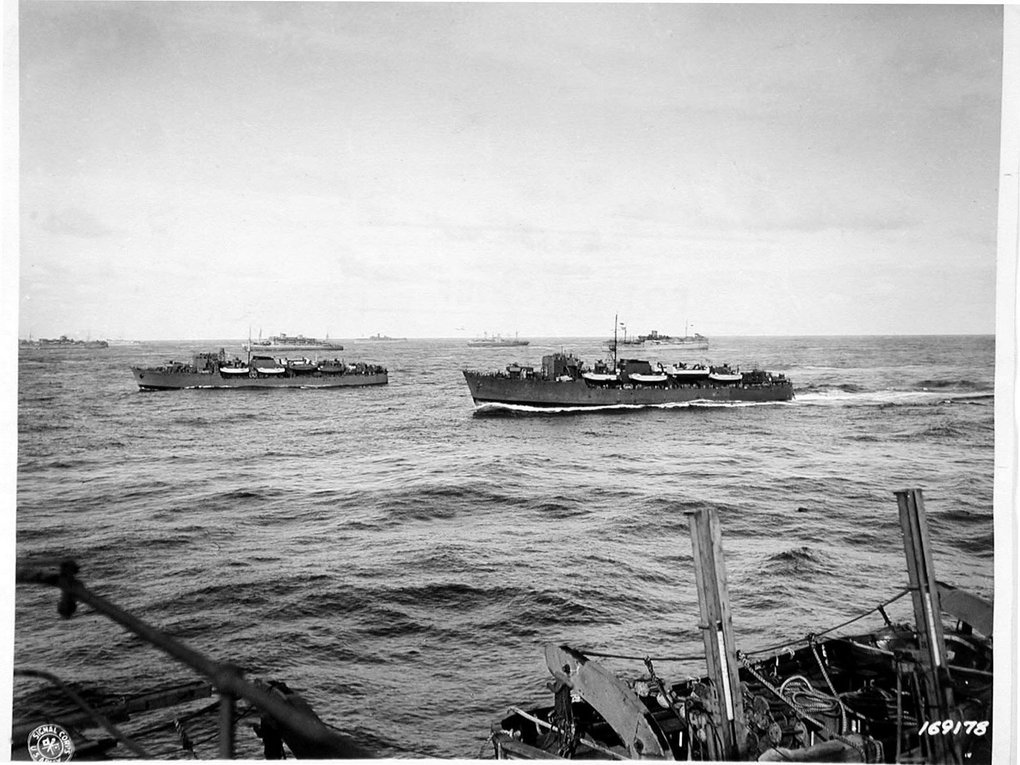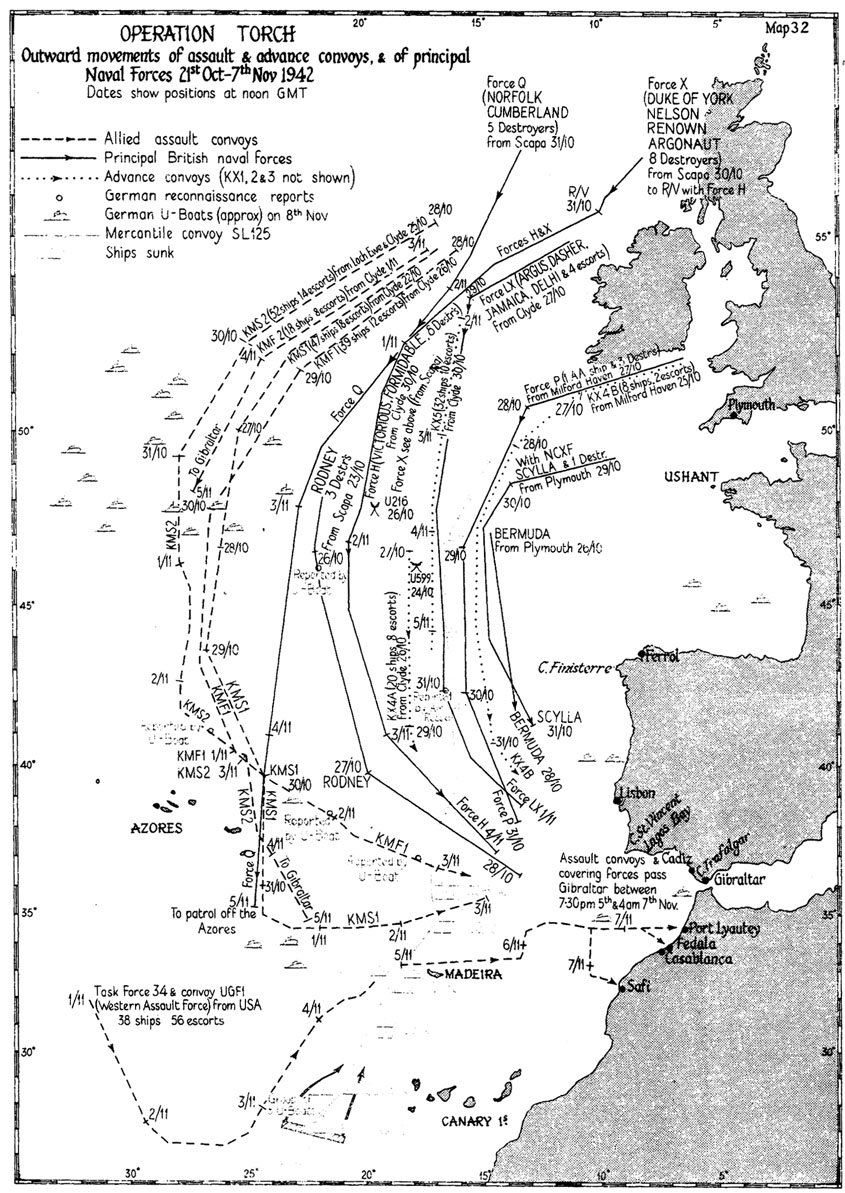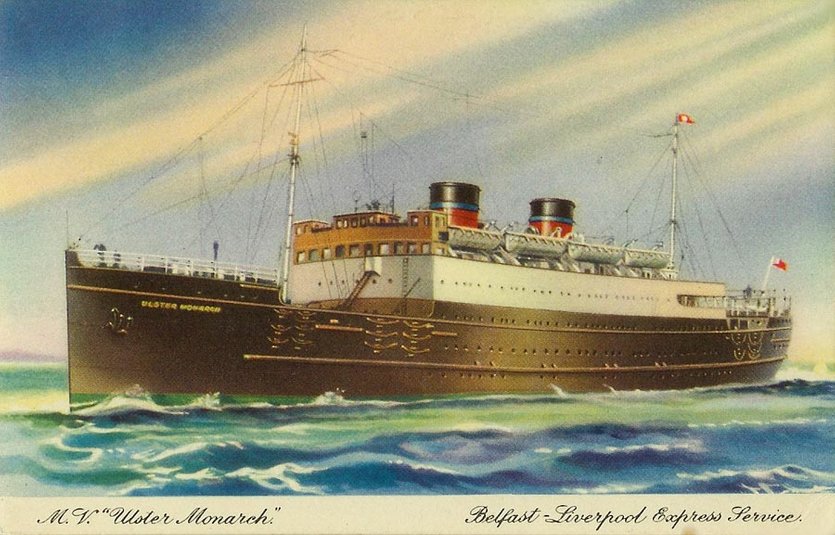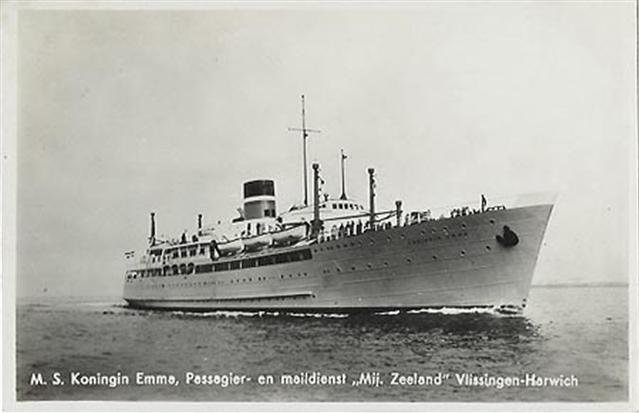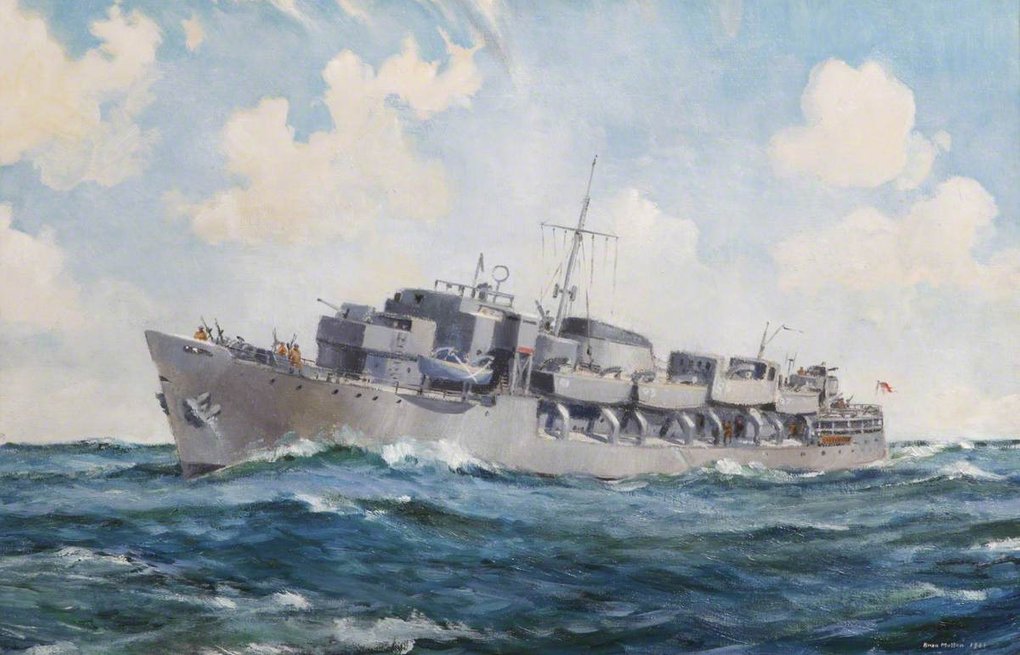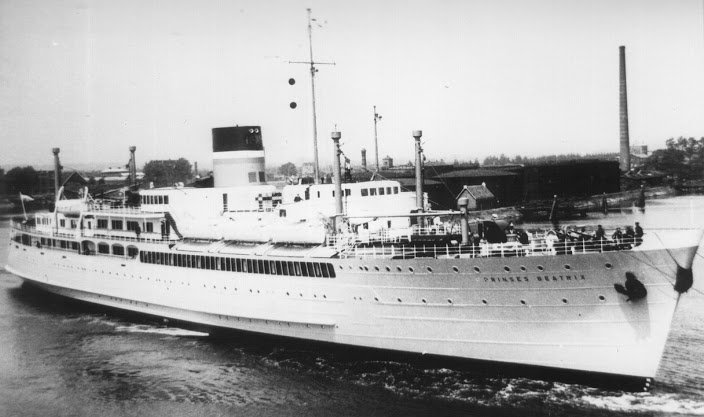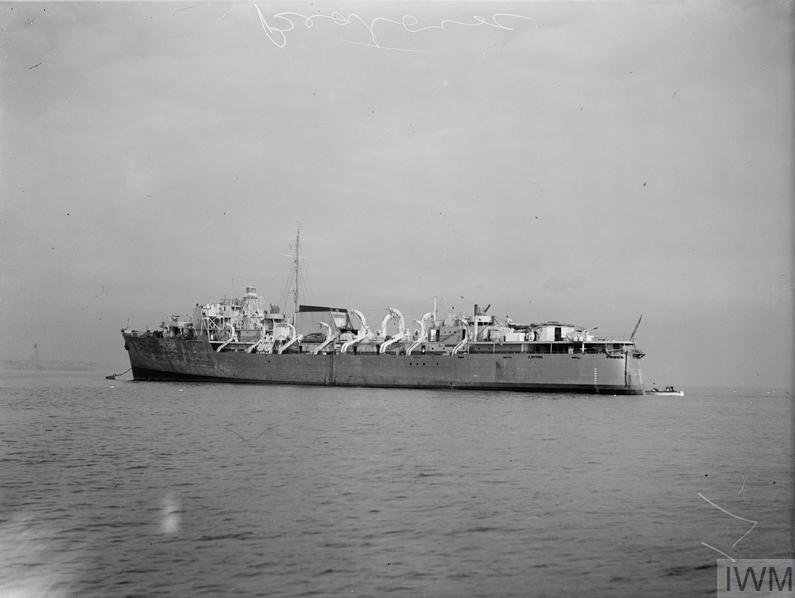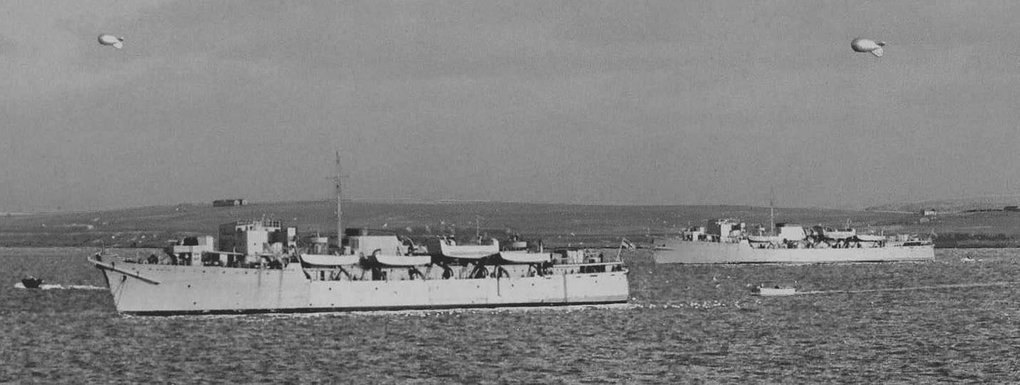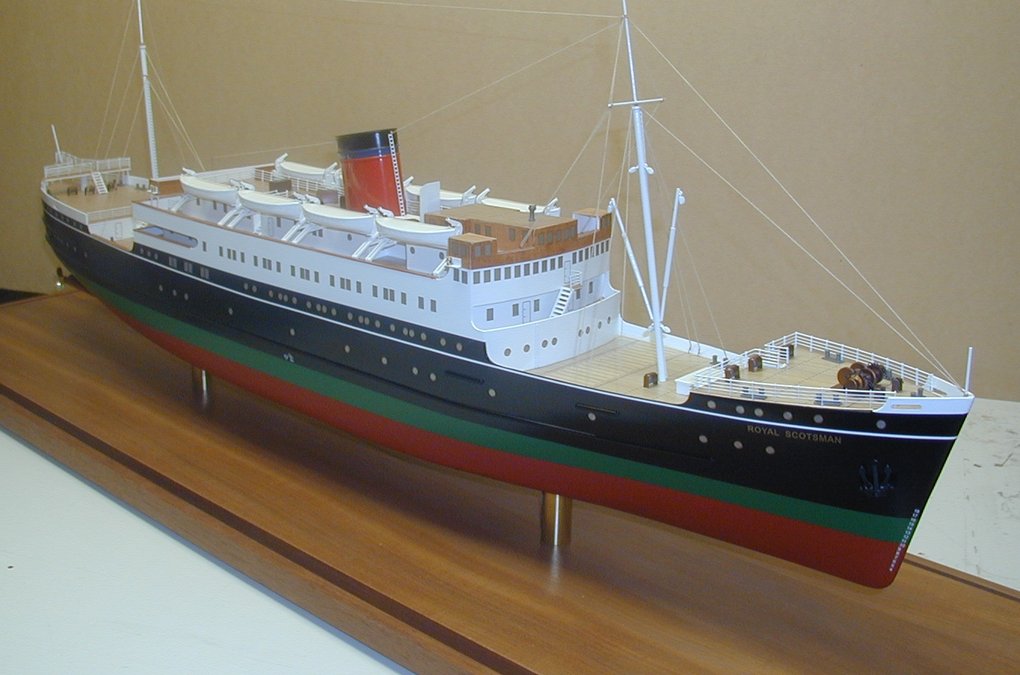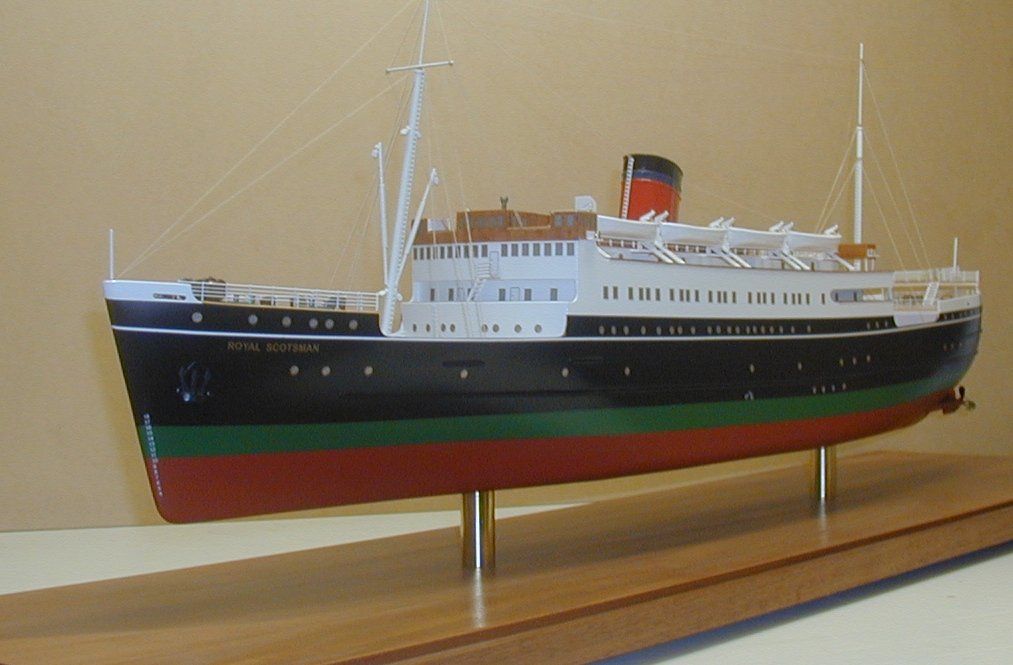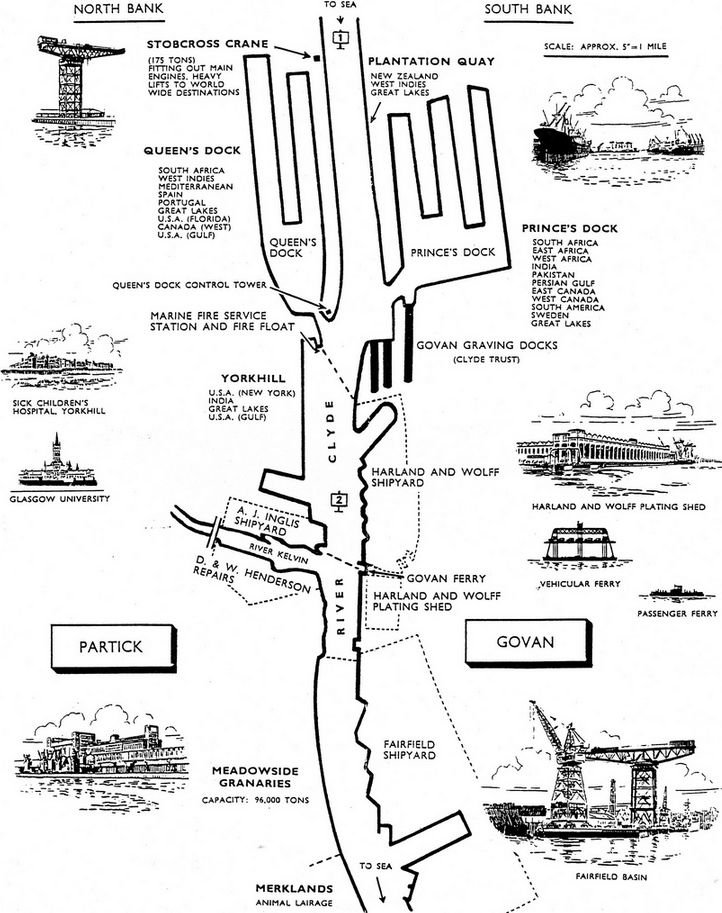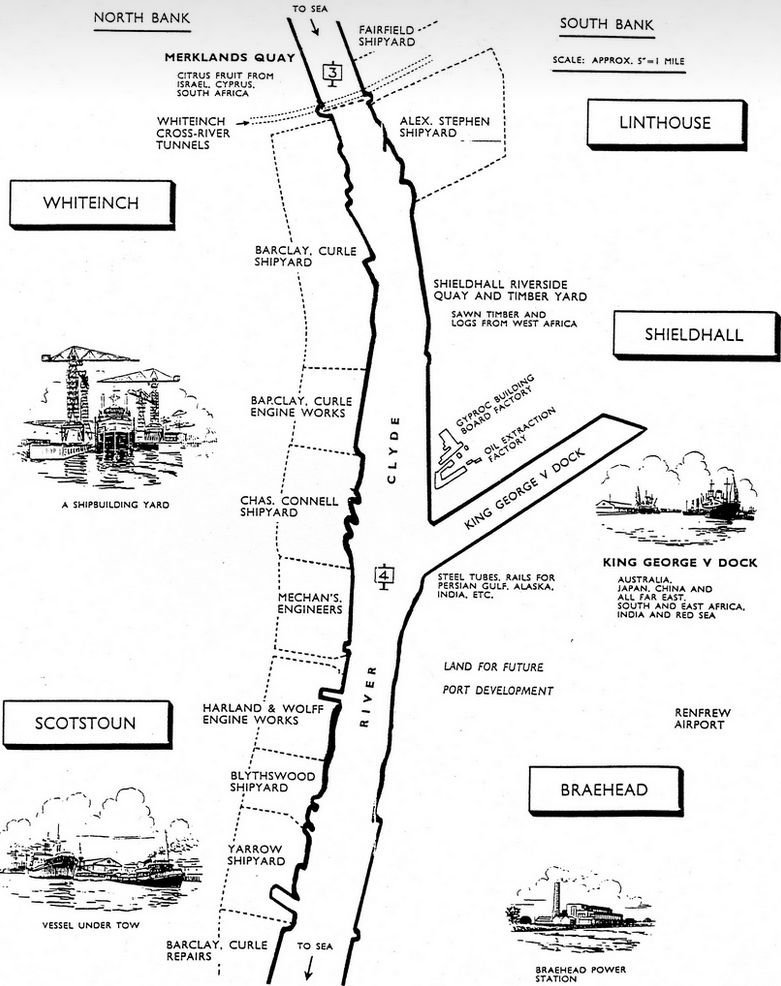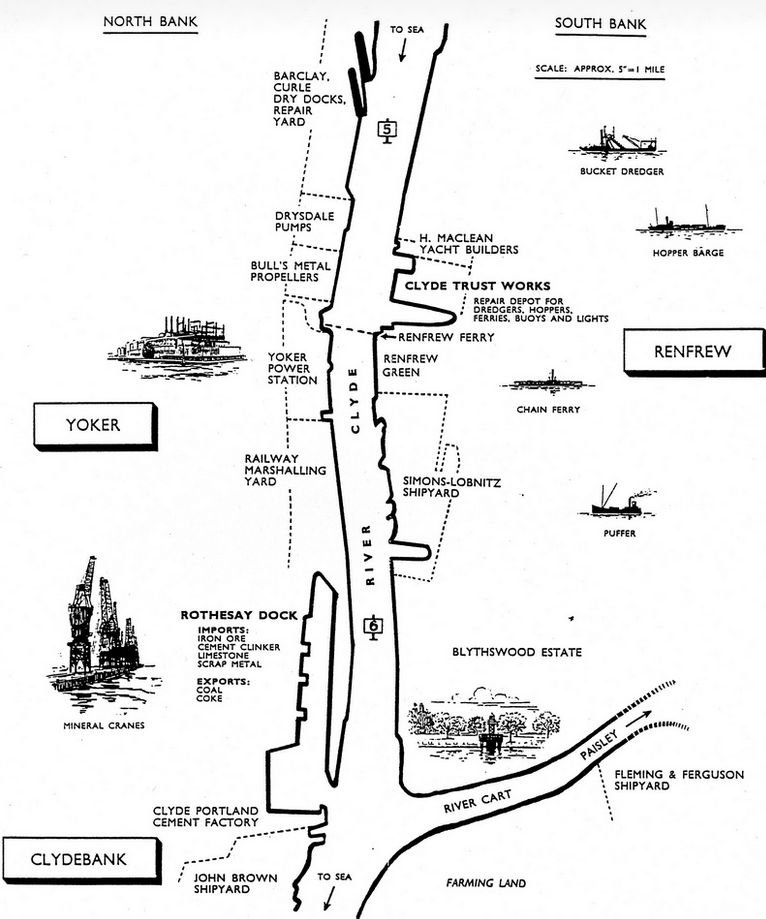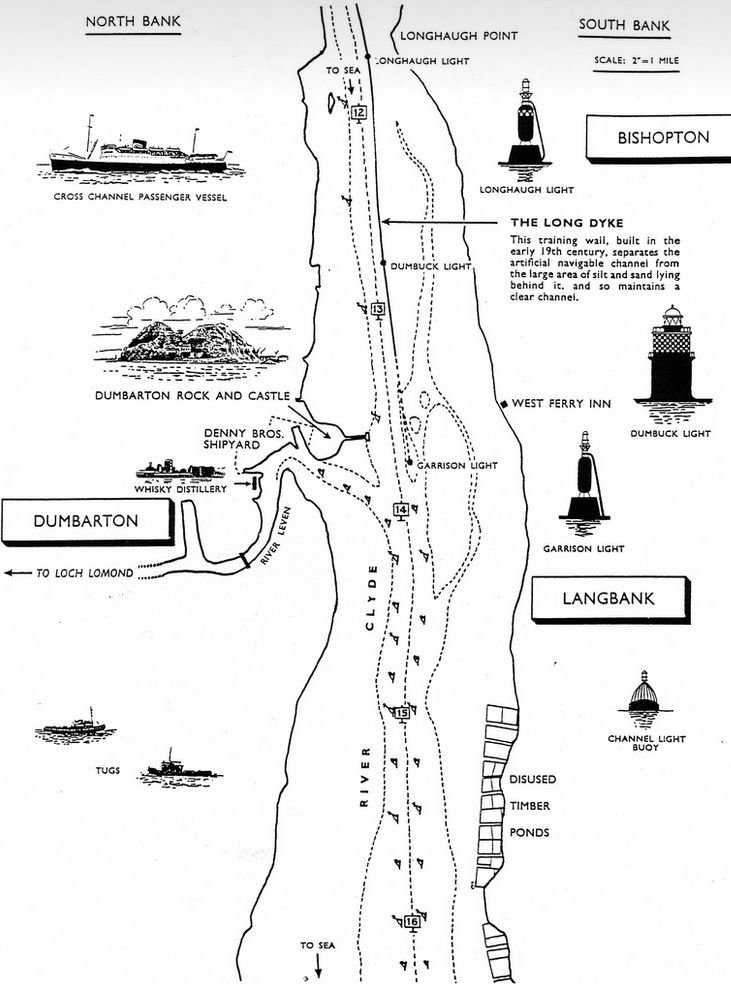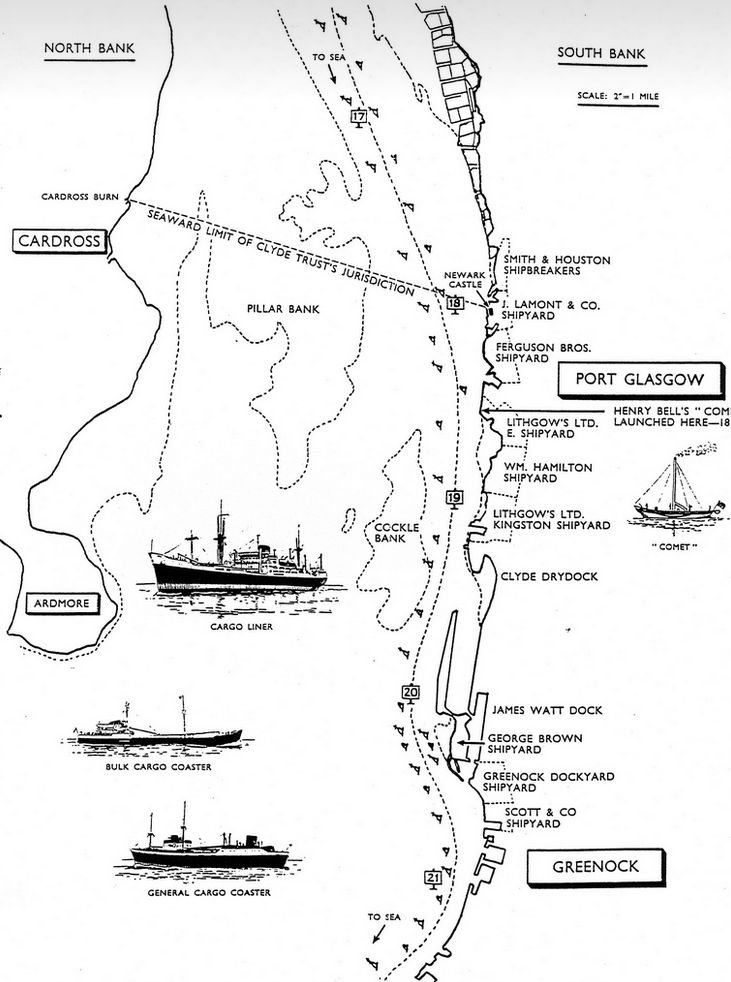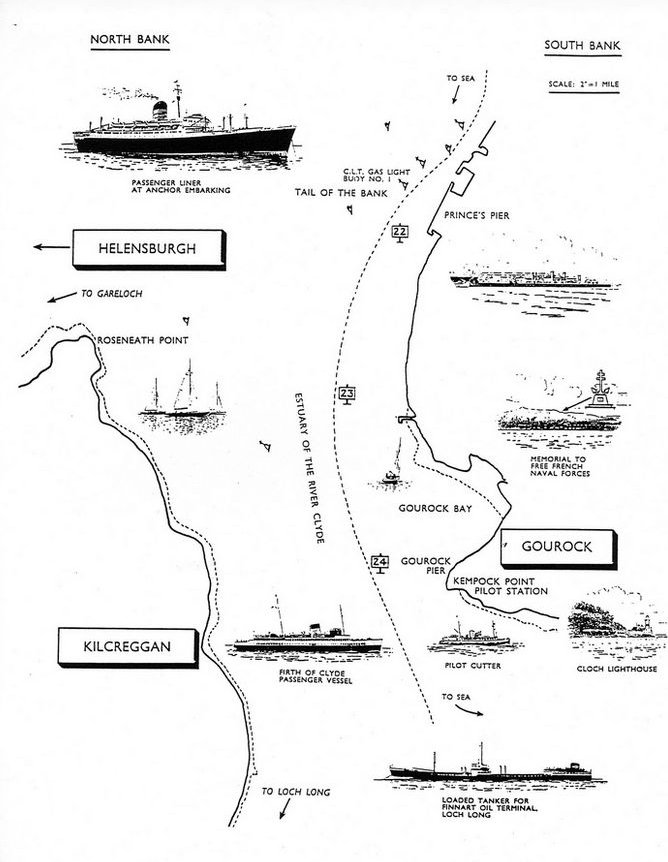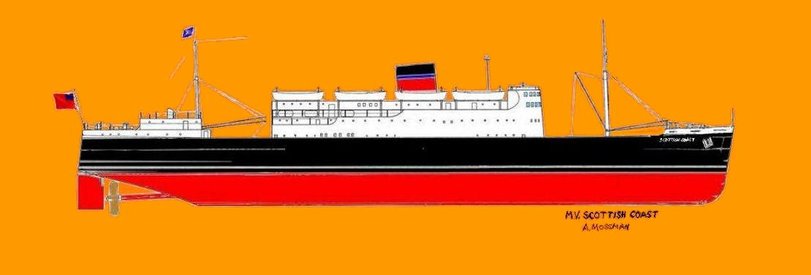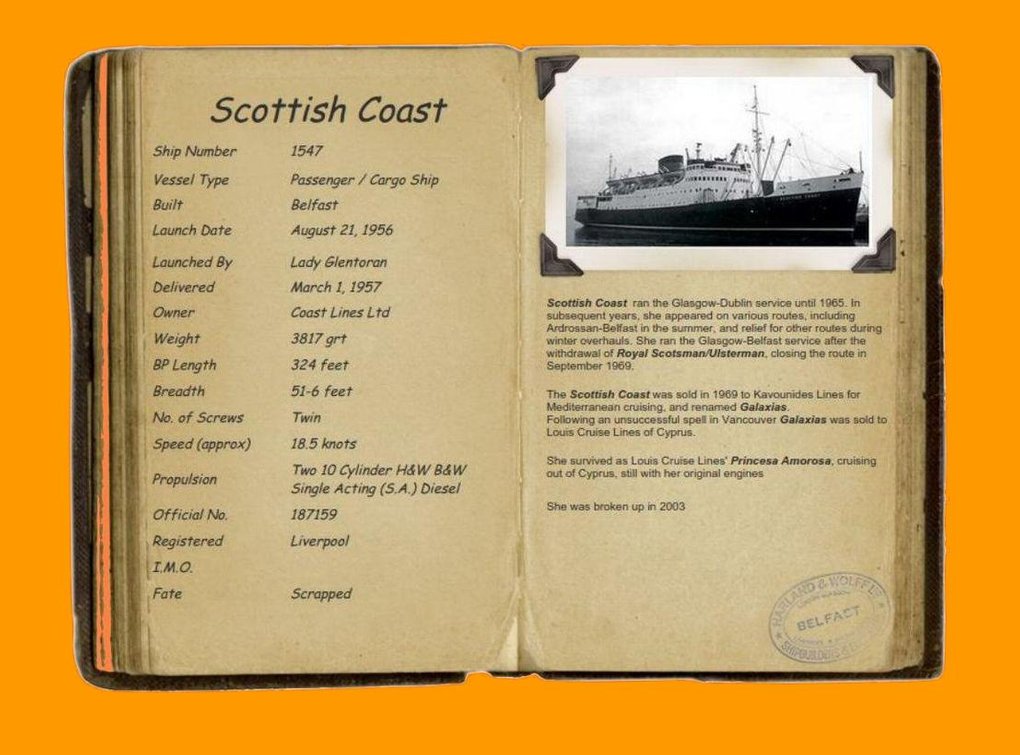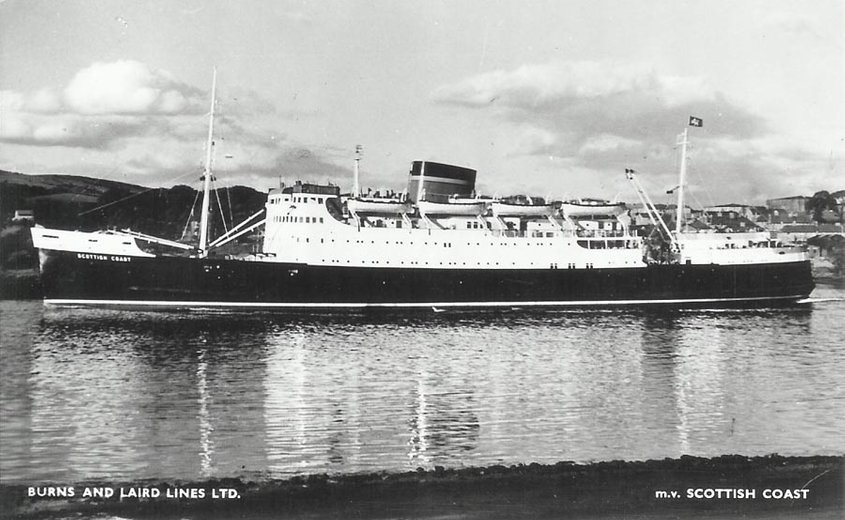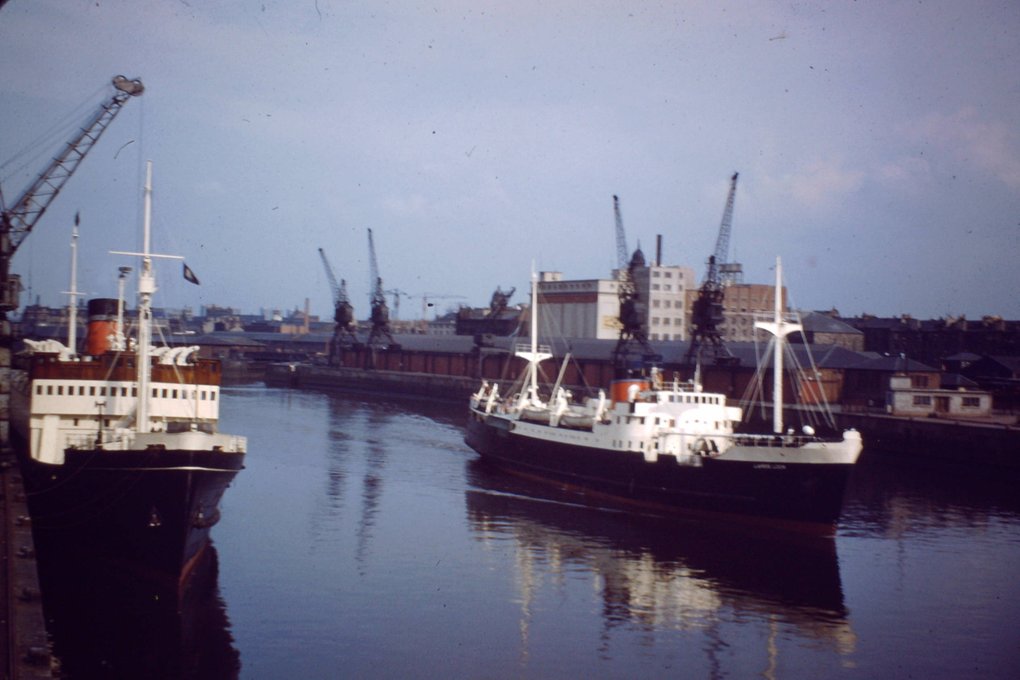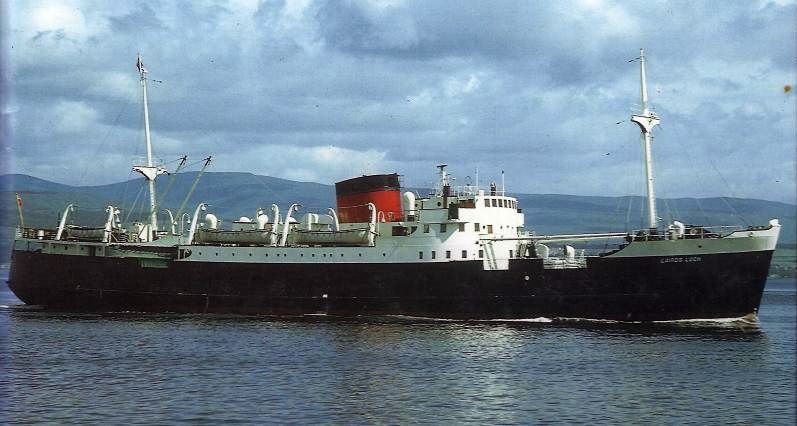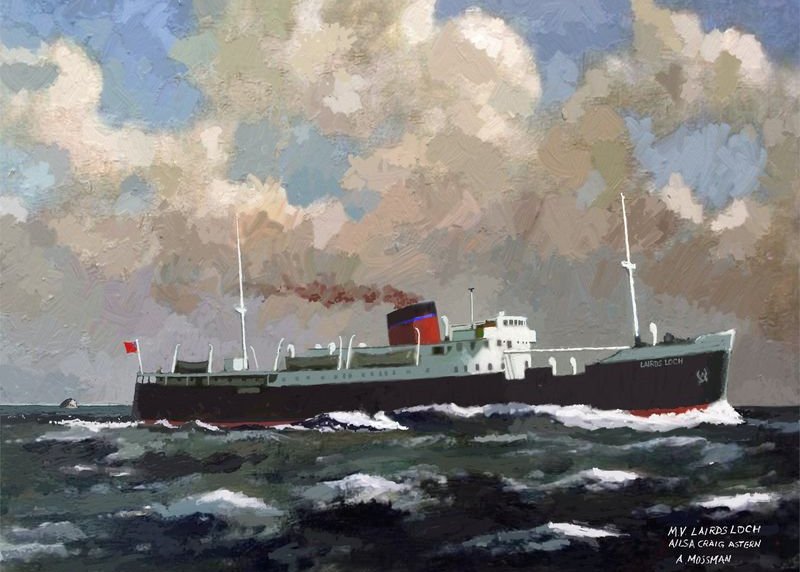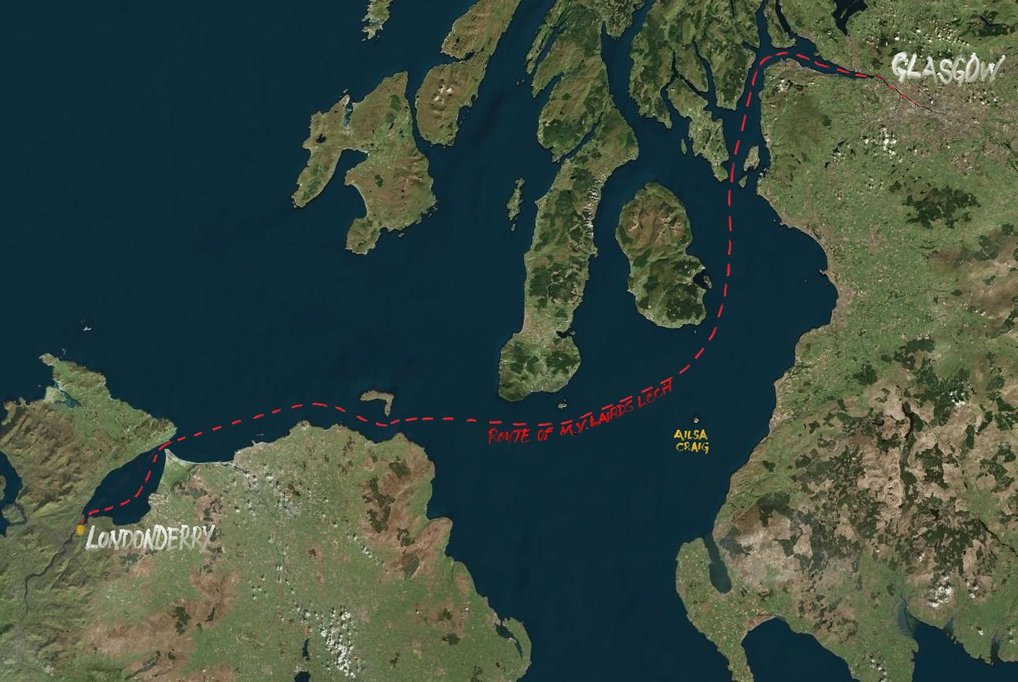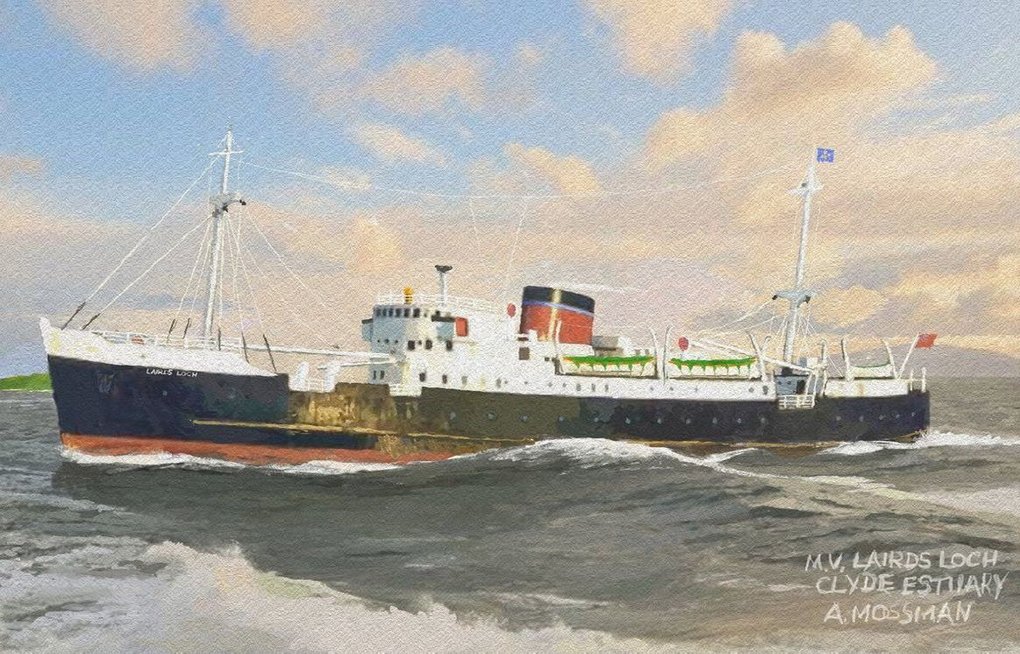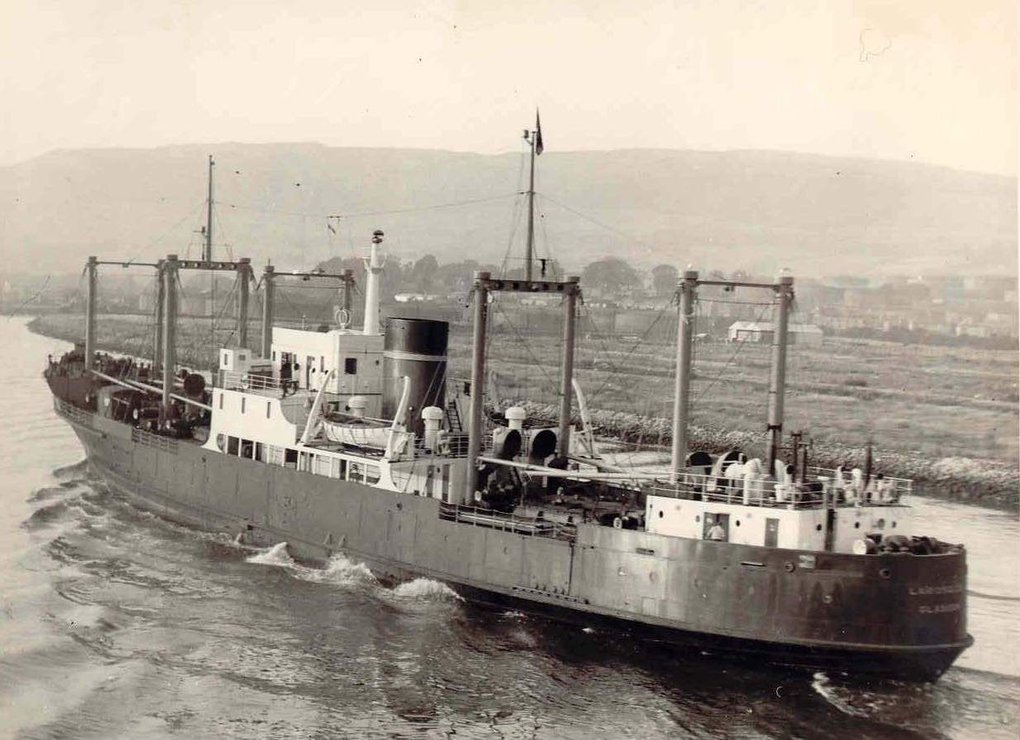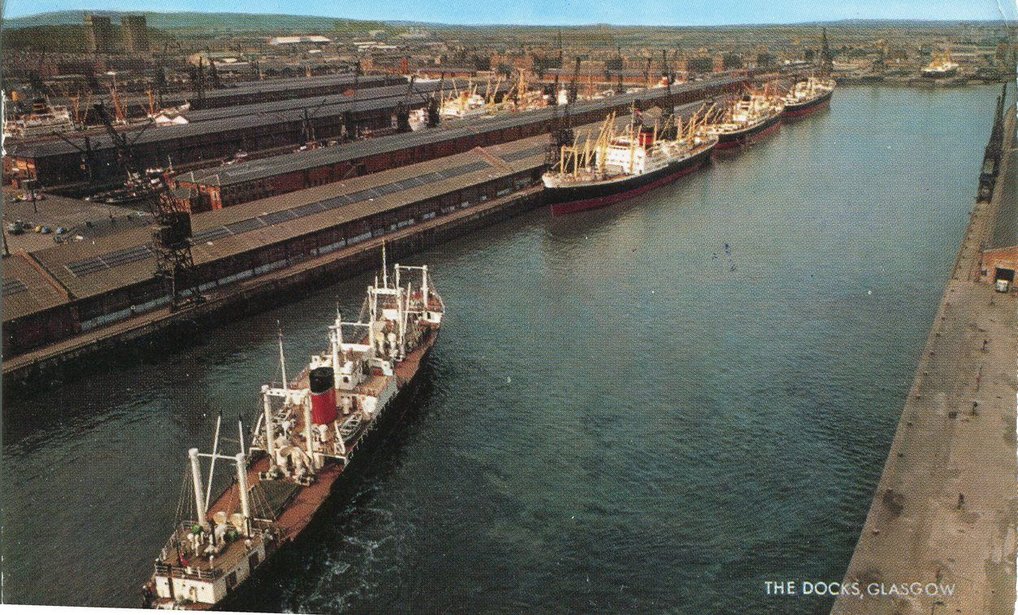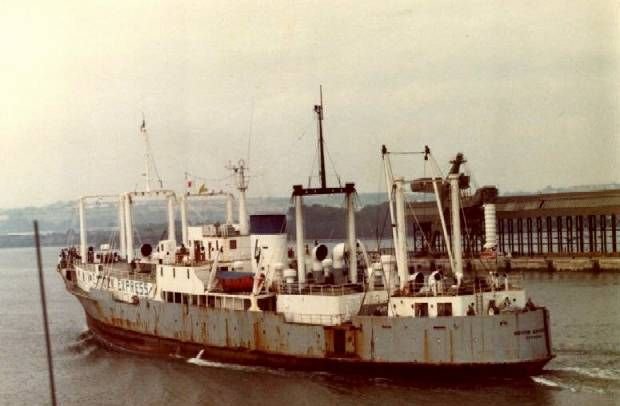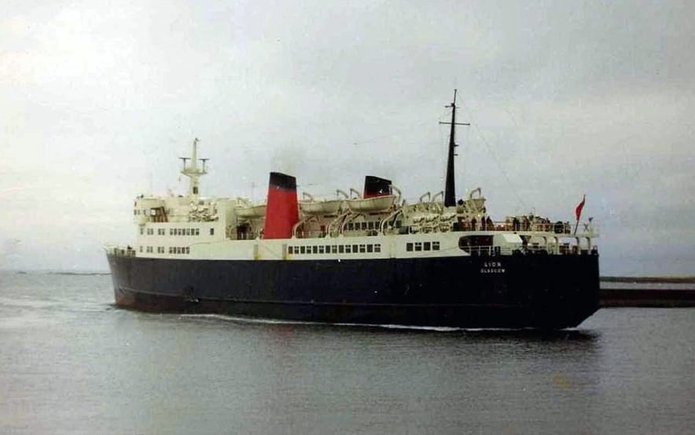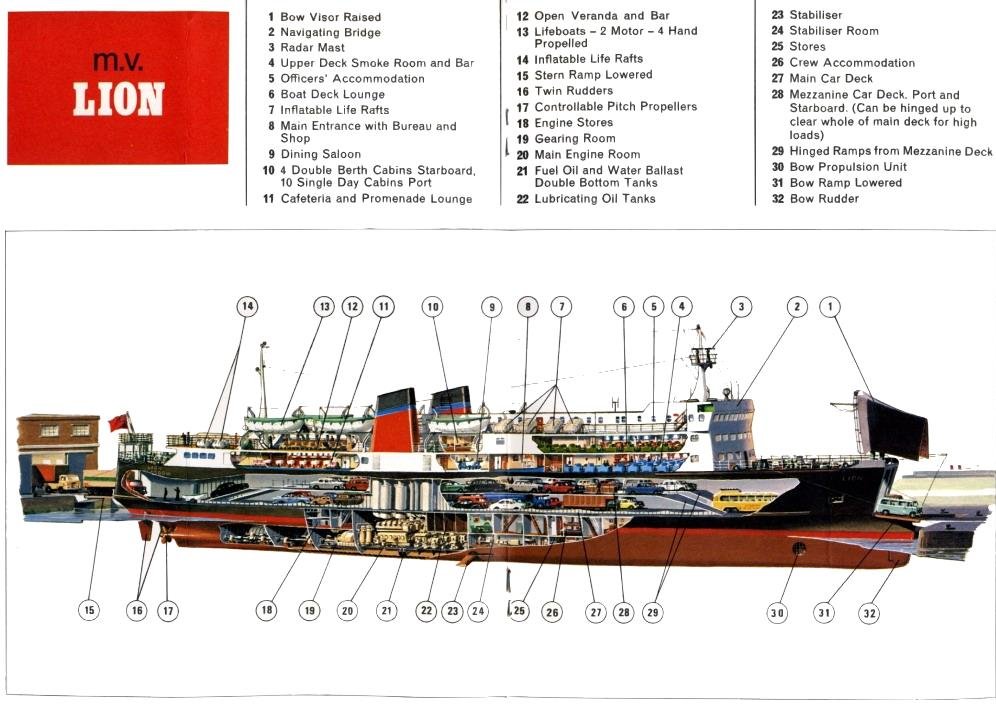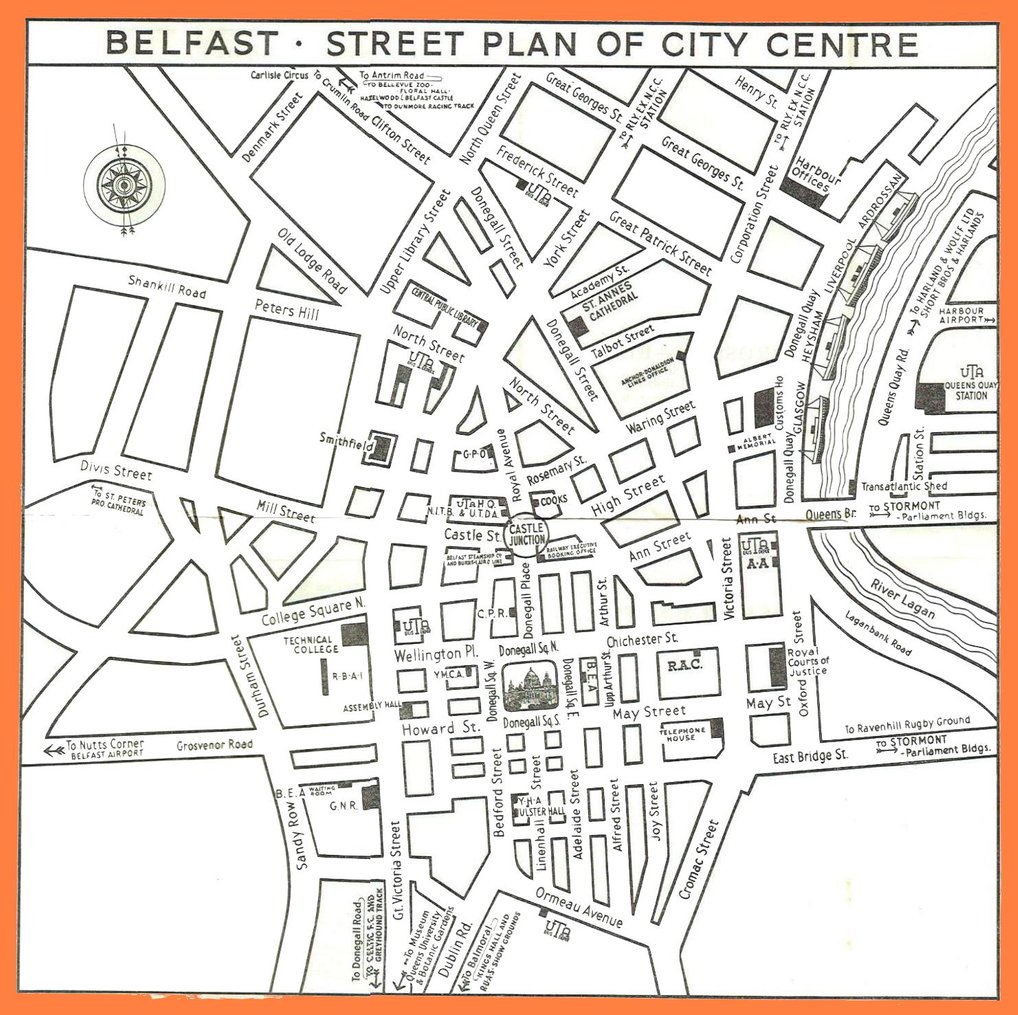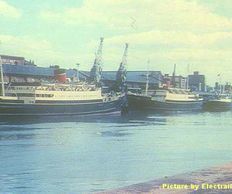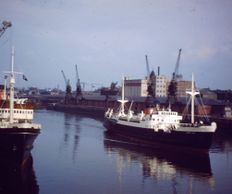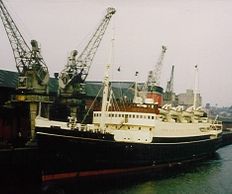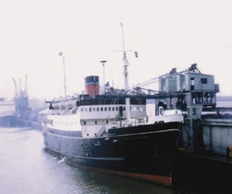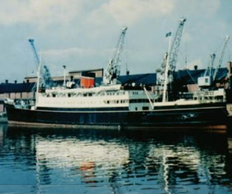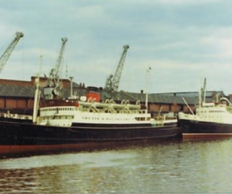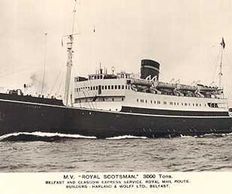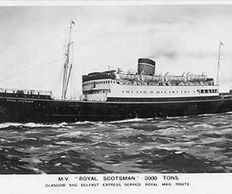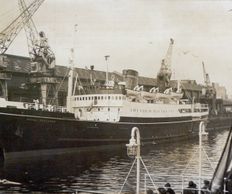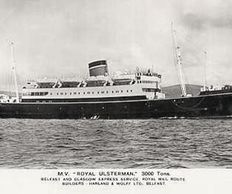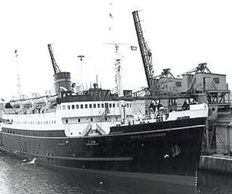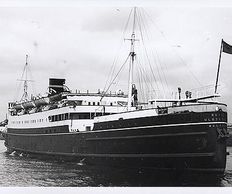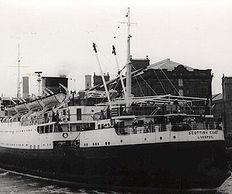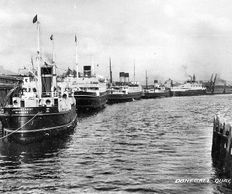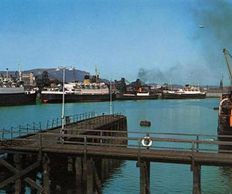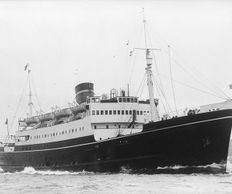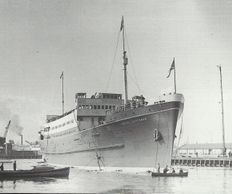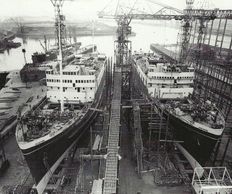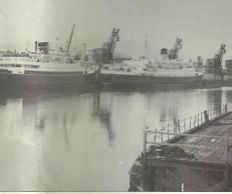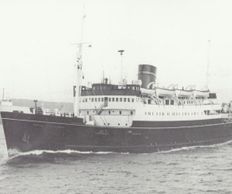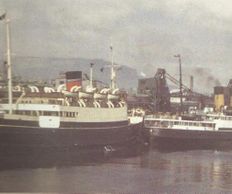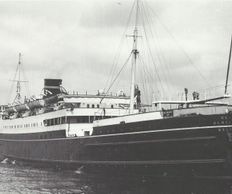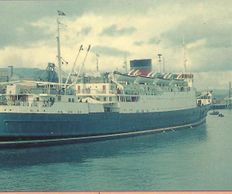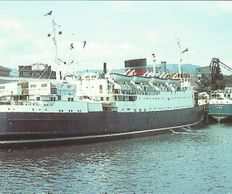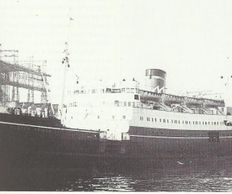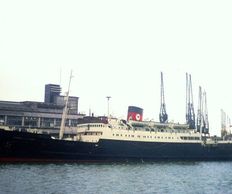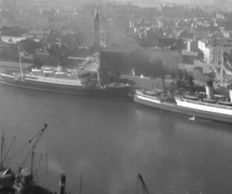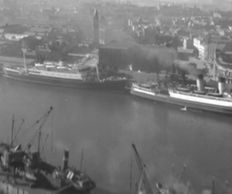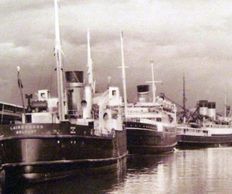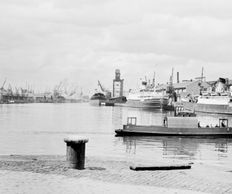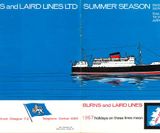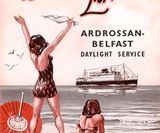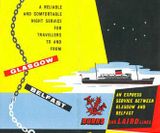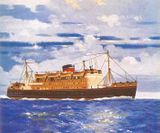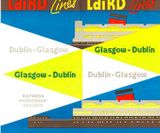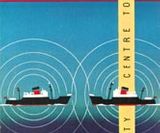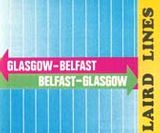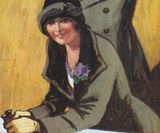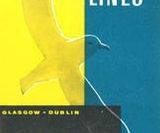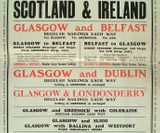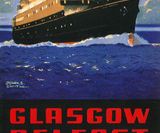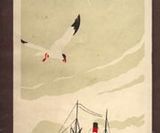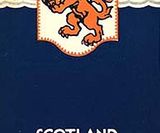Mandalay
Burns and Laird Lines
"Doon the Watter" , 1951 M.V. Lairdsdale Burns & Laird
"Doon the Clyde" , 1951 M.V. Lairdsdale Burns & Laird
Burns & Laird
M.V. Royal Scotsman & M.V. Royal Ulsterman
M.V. Royal Scotsman, M.V. Royal Ulsterman
The two "Royals" above had amazing lifespans as far as ships go. The Ulsterman served for 37 years and the Scotsman 48 years. Today if a ship is more than 10 years old she is considered as not being commercially viable and generally sold off to Chinese, Cypriot or Panamanian registered companies who at the most beat another five to ten years out of her before finally being sold as scrap.
Both ships were driven by two-stroke single-acting eight-cylinder oil engines, working on the airless injection principle, which gave a speed of 19 knots, although a service speed of 14.5 sufficed.
219 first class passengers were catered for in exceptionally comfortable single and double berth state rooms and there was accommodation for 108 in the third class astern.
In the spacious dining saloon, 88 could dine at one sitting and on the bridge deck there was a commodious lounge.
A different scheme of decoration was adopted for each ship.
Sailings on weekdays (except Sundays) from Glasgow (to Belfast) were scheduled to leave at 9 p.m. (2100 hours), arriving at Belfast at 6.30 a.m. next morning. Simultaneously the sister ship left Belfast for Glasgow so the two ships would pass each other on the Irish Sea at night.
Above, from left to right: The 1st Class Lounge, the 1st Class Restaurant and a 1st Class Cabin.
These photographs were taken in 1936 and thus unfortunately in B/W only.
In the brochure above, the "Royal Ulsterman" to the left and the "Royal Scotsman" to the right are depicted passing very close to one another on the Irish Sea . In reality they didn't play "chicken" like this and kept well apart. Both ships not only sailed overnight in darkness, before WWII they were also not equipped with radar - as shown in the brochure's painting where the radar masts are missing (the radar masts first appear in post-war photographs) .
M.V. Royal Scotsman Call Sign GYTM
M.V. Royal Scotsman, 1938
M.V. Royal Ulsterman Call Sign GYWW
Aerial photo of the River Clyde in the heart of Glasgow, shot on the 9th December 1951. This photo is reproduced here with the kind permission of "Britain From Above". The link to this website is:
The extended link to the above photo can be seen on the photograph.
If you use the extended link it will display the photo as above except there are also a number of pins covering parts of it. Clicking on a pin gives information on the pin's target . Pins targetted that the largest of the ships shown was either the "Royal Scotsman" or "Royal Ulsterman" , a dredger was just below in mid-river, below the dredger to the right was berthed "King George V" - the first paddle steamer in the world and that the vessel berthed near the top right was the "Lairds Loch".
Clicking on a pin increases the resolution but zooms down the photo:
Above, the higher resolution photo with the blue "pins"
------~~~~~~~~~~~~~-----
Aerial photo from 1936 of the M.V. Royal Scotsman and the M.V. Duke of Lancaster tied up
at their berths at Donegal Quay on the River Lagan, Belfast. Note that the light reflecting from the RS is dim compared to that from the DoL. The reason for this is that before the war the superstructure of the RS was painted in cream colour (after the war its was painted white). The DoL superstructure is painted white.
Note the Albert Clock Tower in the background. Belfast’s most prominent timepiece was built from 1865-1870 in memory of Queen Victoria’s husband, Prince Albert, who died in 1862. The 43m-high landmark is famous as Belfast’s very own leaning tower. Like many structures in the city, it was built on reclaimed land on the River Farset’s somewhat squishy foundations and the clock tower currently leans 1.25m to the left. The area around the clock was once the stomping ground for ladies of the night ‘servicing’ visiting sailors.
One of the photos taken of the "Belfast Blitz" during WWII. Note the Albert Clock Tower still standing in the background. Comparing this photo to the 1936 aerial photo of the RS and DuL you can see how close the bombs were to the Donegal Quay where the B&L ships berthed during peacetime. During the war both the RS and RU were commandered by the War Office and refitted as landing craft/troop transporters and renamed HMS Royal Scotsman and HMS Royal Ulsterman respectively.
Harland & Wolff, Belfast - Ship List - Royal Scotsman
Harland & Wolff, Belfast - Ship List - Royal Ulsterman
Harland & Wolff, Belfast - The Royal Ulsterman and the Royal Scotsman were built on slips alongside each other. The RU was launched on March 10th 1936 and the RS the next day on March 11th, however, the RS was the first to be delivered to B&L on May 29th 1936, the RU later on June 13th. The RS is to the right on the photograph, her masts not yet installed.
The Belfast Blitz - Harland & Wolff, Belfast - the image above commemorates the bombing attack by the Luftwaffe over Belfast on the night of 4/5th May 1941. A Heinkel bomber is shown evading the searchlights - a perfect night for the estimated 250 bombers that attacked that night. Perfect because the moon was full, the sky cloudless and of the inopportune stance of the British War Office which had sorely neglected the air defence of the city ( as opposed to the air defence of other mainland UK cities such as Liverpool). However, this was not the only bombing attack by any means - Belfast suffered three major attacks which caused massive civilian casualties - the housing for the shipyard workers and other factory workers were built in close proximity to the factories in the middle of Belfast.
The Luftwaffe was aiming not only for the Harland & Wolff shipyard and docks but also for other industrial targets including the Gas Works. Belfast had many industries including munitions factories and the Shorts aircraft factory which built a great number of Stirling bombers and Sunderland flying boats during the war. Not only were the Sunderlands manufactured in Belfast but many of them were based in Northern Ireland in loughs from where they flew from as U-Boot hunters to protect the Atlantic convoys. As the war continued they became with the aid of radar pogressively successful with their attacks.
The heavy lift cranes shown in the image above are iconic Belfast landmarks and were christened "Samson" and "Goliath". These engineering heavyweights stand at 96m and 106m height, 140m width and were built in 1969 and 1974
respectively. They were manufactured (ironically) by the German Krupp A.G.
Belfast’s shipbuilding industry may have dwindled but the cranes are still used for H&W’s heavy engineering projects and have been preserved as historic
monuments.
The artist who painted the poster added them for effect - if he (or she?) had omitted them thecontemporary public response would have been: "It's a great poster but it definitely isn't Belfast!".
Sunderlands moored ready for delivery to the RAF with cranes of H&W in the background.
Sunderland on patrol over a North Atlantic convoy.
German Luftwaffe Reconnaissance Photography of Harland & Wolff, Belfast
The following are three German photo reconnaissance images taken over Belfast.
The first shows East Belfast with areas of H&W to the left. The second shows almost totally the complete H&W shipyard area - unfortunately the resolution of this image is low. The third and last image targets the Gas Works which have been enclosed in red and marked "A". The Queen's and Albert bridges over the River Lagan can be clearly seen at the top of the image.
They knew what they were looking for!
The "White Duster"
The War Service of
HMS Royal Scotsman & HMS Royal Ulsterman
HMS Royal Scotsman
HMS Royal Scotsman was a LSI (Landing Ship Infantry) of the British Royal Navy that served during World War II. A former passenger ferry, she saw action in the Mediterranean during the invasions of North Africa (Operation Torch), Sicily and Italy.
Construction
The ship was built by Harland and Wolff at Belfast for the Burns and Laird Lines as Yard No. 964. Launched on 11 March 1936, the ship was completed on 29 May 1936 and entered service as MV Royal Scotsman as a passenger and cargo ferry in the Irish Sea, operating between Belfast and Glasgow.
Operational history
Royal Scotsman was requisitioned by the Admiralty in October 1940 for use as a store ship, commissioned as HMS Royal Scotsman, and modified for use as a Landing Ship, Infantry. Work was completed by January 1941 and she prepared for operational service. Most of the ship's company were the original merchant crew who had joined the Navy under T124X engagements (which meant that they could not be transferred to a combat ship), while the captain and some specialist officers were from the Royal Navy or Reservists.
Initially deployed in home waters, in August 1941 she embarked troops at the Clyde for "Operation Grey", a planned occupation of the Azores. After sailing to Scapa Flow to join military convoy WS8C, the operation was cancelled, and Royal Scotsman returned to the Clyde. On 17 September 1941 she joined military convoy WS11X in the Clyde to transport military personnel to Gibraltar, as reinforcements for Malta ("Operation Halberd"), returning to the UK in October to train with Combined Operations personnel.
From January 1942 she took part in extensive exercises for amphibious operations, and on 26 October sailed to Gibraltar as part of military convoy KMF1 for the invasion of North Africa in "Operation Torch". In the early hours of 8 November she landed men of the American 1st Ranger Battalion to capture the port of Arzew, and then was deployed to transport troops and equipment in the western Mediterranean, operating with her sister ship Royal Ulsterman, and the Dutch ships Princess Beatrix and Queen Emma.
In May 1943 she took part in landings on the Italian island of Pantelleria ("Operation Corkscrew"), then on 10 July landed troops on the beach codenamed "Bark South" during the Allied invasion of Sicily. In September she sailed to Tripoli to embark troops, and joined military Convoy TSF1 to land troops at Salerno on the 9th. In November 1943 she returned to the UK.
There is no record of her being deployed in any further operations, though whether the ship was damaged or only used for training purposes is unknown. In February 1945 she was decommissioned and returned to her original owners in March.
She remained in service with Burns & Laird until 1967, when she was purchased by the Church of Scientology, to serve as flagship of the Sea Org, and was renamed Apollo. The ship was scrapped in Texas in 1984.
The B/W photographs displayed below are the property of the Imperial War Museum (IWM). To download any of these, go to their IWM website directly. If you download
them from this website instead, you will remain unaware of the IWM's terms & conditions of use. The live-link to the IWM is:
On the IWM website, next to "Search our collections" is a box. Fill the box in with " hms royal scotsman" or "hms royal ulsterman" (without the " characters before h and after n).
HMS Royal Scotsman Greenock, 5th August 1942 © IWM(A11076)
HMS Royal Scotsman Greenock, 5th August 1942 © IWM(A11077)
HMS Royal Scotsman Greenock, 5th August 1942 © IWM(A11078)
HMS Royal Scotsman Greenock, 5th August 1942 © IWM
HMS Royal Scotsman Stationary © IWM(FL 18390)
HMS Royal Scotsman Greenock, 5th August 1942 © IWM(A11080)
HMS Royal Ulsterman
Commissioned in 1936, HMS Royal Ulsterman was a 3,250 ton passenger ship which, along with her sister-ship, Royal Scotsman, sailed the Glasgow-Belfast run for Burns and Laird Lines Ltd. During the Second World War, HMS Royal Ulsterman served as a Royal Navy Reserve troop transport, taking part in nearly all of the major Allied amphibious operations of the European war, including the Dunkirk evacuation; Operation Neptune (the amphibious part of the D-Day landings); and the liberation of the Channel Islands.
Wartime Service
Operations off Norway:
Commissioned HMS, Royal Ulsterman landed elements of the British Expeditionary Force for operations in Norway in 1940. Subsequently, the ship delivered armaments to Harstad, high above the Arctic circle.
Operation Aerial - The evacuation of the BEF and allies from France
On 18 June, HMS Royal Ulsterman embarked some 2,800 troops and three civilian women at St. Nazaire, transporting them to Falmouth in Cornwall. By the end of August, she had also moved French personnel to Casablanca, carried civilian refugees from the Mediterranean region to Glasgow, and landed some 700 troops at Iceland. Over the next year, HMS Royal Ulsterman would make regular trips between the British Isles and Iceland. During one of these runs, HMS Royal Ulsterman, under the command of Captain Harry Houghton, carried the three survivors of HMS Hood (the British battlecruiser sunk by the German battleship Bismarck), back to the UK.
On 29 August 1941, off the west coast of Scotland, HMS Royal Ulsterman was holed in a collision with the destroyer HMS St. Mary's, requiring repairs on the Mersey until late September.
Operation Ironclad
HMS Royal Ulsterman took part in Operation Ironclad (the battle of Madagascar), landing elements at Diego Suarez on 5 May 1942.
Operation Torch
HMS Royal Ulsterman took part in Operation Torch (the Allied invasion of North Africa), landing United States Army Rangers of the 1st Battalion on the Algerian coast on 8 November 1942. On 14 November, while ferrying troops from Oran to Algiers, the ship was attacked, unsuccessfully, by five Luftwaffe aircraft.
Operations Husky and Avalanche
On 10 July 1943, HMS Royal Ulsterman disembarked troops of the British 8th Army in Sicily for Operation Husky. She subsequently took part in Operation Avalanche, landing troops on 9 September 1943 at Salerno on the Italian mainland.
Operation Neptune
After a two-month-long refit at Southampton in March and April 1944, HMS Royal Ulsterman took part in Operation Neptune, the amphibious operation that launched Operation Overlord, the Allied invasion of Normandy on 6 June 1944. The ship disembarked troops of the 9th brigade of the 3rd Canadian Infantry Division on Juno Beach.
Liberation of the Channel Islands
Seized by the Germans in 1940, the Channel Islands were the only part of the British Isles to be occupied by the enemy during the Second World War. Not until after Germany's surrender were the islands liberated. HMS Royal Ulsterman landed British troops on Jersey on 11 May 1945 and provided additional reinforcements on 18 May.
Postwar History
HMS Royal Ulsterman returned to Belfast in November 1945 and was decommissioned on 20 December. After reconditioning, she resumed work on the Glasgow-Belfast run for her shipping company Burns & Laird. She served in this capacity until 1967. Sold to the Mediterranean Link Lines of Famagusta and renamed MV Sounion, she later sank at a pier in Beirut, Lebanon on 3 March 1973 after a sabotage attack and was subsequently scrapped.
HMS Royal Ulsterman Underway © IWM(FL 12259)
HMS Royal Ulsterman Greenock, 22nd March 1944 © IWM(A22477)
OPERATION AERIAL
June, 1940
The evacuation of the BEF and other allied troops from Western France.
The evacuation of troops from Dunkirk in 1940 is considered by many as a miracle brought about by the mad dash across the English Channel of anything that could float. No doubt that such heroic action by many a "weekend sailor" saved an untold number of lives but what the general public are not aware of is the scope and command structure of the evacuation. The evacuation encompassed not just French Channel ports such as Dunkirk but the whole of the Western seaboard of France and also French Mediterranean ports.
The number of merchant and warships which took part is unbelievable and their movements were controlled by the Admiralty - this was no "mad dash" operation!
A day by day and minute by minute account of the vessels involved can be read at the website www.naval-history.net
The n-h website is a goldmine for anyone interested in naval history. Below I have extracted paragraphs from their "Evacuation" page which deal with the movements of the MV Ulster Monarch, MV Royal Scotsman, MV Royal Ulsterman, MS Koningin Emma & MS Princes Beatrix . These vessels later comprised "The Moonlight Squadron" during Operation Torch.
During the evacuation these vessels were still merchant navy vessels - all of them had been passenger ferries when war broke out. After the evacuation, all of these vessels were inducted in the Royal Navy. Instead of MV the Ulster Monarch, Royal Scotsman & Royal Ulsterman were preceded HMS; likewise the Dutch vessels exchanged MS for HMS but also their names were anglicised to HMS Queen Emma & HMS Princess Beatrix.
La Pallice (in the following account) is now part of the port of La Rochelle in the Bay of Biscay.
During the war the Germans built U-boat pens there which are still standing. Being massive reinforced concrete bunkers, it was too expensive to break them up and so they remain today and can easily be seen in satellite photos. I once joined a German ship there which was berthed in the same basin as the submarine pens and I had also been to La Pallice previously with another ship.
The La Pallice that I remember was a small picture-postcard Ville and had a quaint Bistro with pretty barmaids. The atmosphere inside was tuned to Mireille Mathieu jukebox "chansons" being played almost non-stop apart from interludes of "Je t'aime...moi non plus", which was a big hit at the time (1969) being sung (or better said spoken) by a 23 year old English (?*#) girl Jane Birkin accompanied? by Serge Gainsbourg. The sexually implicit lyrics of the song caused a worldwide scandal (once the non-French speaking public found out what they were actually singing). Birkin & Gainsbourg took the lyrics to heart and had an affair which lasted 13 years.
The image above is believe it or not a "Paint By Numbers" painting from the early 1950's of a French Ville by an unknown PBN artist. When I first saw it I thought to myself "that looks just like La Pallice" . Although since the end of WWII 24 years had passed before I myself set foot there, I imagined at that time that it had not changed much since 1940.
Other towns mentioned below are Arcachon, Bayonne, Brest, Gironde, Nantes, Le Verdon, Loire, St.Malo and St.Nazaire.
THURSDAY 13 JUNE 1940
Convoy FF2, Clyde to St Nazaire: Ulster Monarch, Royal Ulsterman, Royal Scotsman and Ulster Prince.
SATURDAY 15 JUNE 1940
ETTRICK, KONINGIN EMMA, ROYAL ULSTERMAN & ROYAL SCOTSMAN were ordered to sail to La Pallice.
Brest Departures Mon Jun 17, 1940 CITY OF DERBY, KONINGIN EMMA, LYCAON, STRATHAIRD, ULSTER MONARCH.
SUNDAY 16 JUNE 1940
Admiral Ouest was asked to sail ROYAL SCOTSMAN & ROYAL ULSTERMAN as soon as possible to Loire where they were urgently required to embark personnel.
ETTRICK, KONINGIN EMMA & LADY OF MANN were also to proceed to Quiberon Bay to embark troops from Loire.
At the end of June 16th the position was that 11000 troops had been embarked at St Malo, leaving 5000 there. 10500 had embarked at Brest, leaving 16000 there. 17,000 had embarked at St. Nazaire, leaving 30000 there. The embarkation at Nantes was proceeding satisfactorily.
MONDAY 17 JUNE 1940
KONINGIN EMMA arrived Plymouth (1838/17).
TUESDAY 18 JUNE 1940
S.N.O. Brest reported (0317) that French troops landed Brest Monday (17th) ex ROYAL SCOTSMAN from Narvik did not wish to be evacuated to the United Kingdom, 400 Polish in ULSTER MONARCH were allowed to remain in ship.
STRATHAIRD arrived Plymouth (0608) MACKAY & ROYAL SCOTSMAN arrived Plymouth (0635)
Convoy OLIVE sailed Loire (0630) - ROYAL ULSTERMAN 2800, ULSTER PRINCE 2800.
D.9.ordered WINCHESLEA (0647) to send any small transports at Quiberon to St. Nazaire forthwith, and also ordered ROYAL ULSTERMAN back to St. Nazaire (0653).
D.9. reported :- (1828)
Convoy: ROYAL ULSTERMAN, CITY OF LANCASTER, BELTOY, MAURICE ROSE, GLANLEA (GLENLEA?), HARPATHIAN, GLENDENNING, POLLUX, LECHISTAN containing troops sailed 1100
At 2309 H. Ship ST. JULIAN arrived Plymouth. KONINGEN EMMA sailed 2244.
FRIDAY 19 JUNE 1940
ULSTER MONARCH ordered from Falmouth to La Pallice (1136).
IMOGEN, PUNJABI, GRIFFIN, WITCH, HARVESTER, VISCOUNT ordered to St. Nazaire (1534) also transports ROYAL SCOTSMAN & SOBIESKI.
KONINGIN EMMA ordered to be available for evacuating refugees from Arcachon fortress as ordered by British Consul.
SATURDAY 20 JUNE 1940
WINCHELSEA & ROYAL SCOTSMAN with 300 troops detached from convoy to Falmouth at 0500 by VANQUISHER.
ULSTER MONARCH ordered to La Pallice – Gironde area (1047) to return to U.K. if no British warships met in vicinity.
Falmouth instructed (1240) to sail ULSTER MONARCH to Plymouth. Sailed (1830)
C.S.2. informed (1351) by C-in-C W.A. Polish division assembling Le Verdon for evacuation. Also 3000 French air pilots and mechanics. Shipping at La Pallice, LADY OF MANN, ORMONDE, KONINGIN EMMA, on passage thither St. Helier ,PRINCESS BEATRIX, BLAIR NEVIS, DELIUS.
GRIFFIN reported (1448) have met ETTRICK off Belle Isle and told her to remain in company.
ROYAL SCOTSMAN also present.
GRIFFIN instructed (1808) to send ETTRICK and ROYAL SCOTSMAN to La Pallice – Gironde area to report to any British warship.
GRIFFIN reported (1902) VISCOUNT detailed to escort BRITANNY past Ushant. GRIFFIN and WITCH escorting KAIPAKI, ROYAL SCOTSMAN.
ULSTER MONARCH arrived (1930) Plymouth
ROYAL SCOTSMAN ordered to join MACKAY off Gironde entrance and ETTRICK to proceed Bayonne (2211)
SUNDAY 21 JUNE 1940
Reference C. in C. W.A's 2211/20 MACKAY reported (0029) that both ETTRICK & ROYAL SCOTSMAN stated that they had only sufficient fuel to reach U.K. MACKAY therefore escorting both to Plymouth.
M.V. P. RAPOULT arrived Plymouth (1151), PRINCESS BEATRIX (1344)
LORD GREY requested (2040) that instructions should be sent to ROYAL SCOTSMAN; who was awaiting MACKAY at Gironde, and enquired the position of GLENAFFRIC.
C.S.2 was informed (2258) She was informed that ROYAL SCOTSMAN should have already arrived at Gironde.
MONDAY 22 JUNE 1940
C.S.2. informed by C. in C. W. A. that LORD GREY reported ROYAL SCOTSMAN off Gironde awaiting orders.
BERKLEY reported (0720) DELIUS, ROYAL SCOTSMAN & CLAN FERGUSON expected to begin embarkation (0815)
BERKLEY reported (1006) that Port Dunedin, DELIUS & ROYAL SCOTSMAN were sufficient for embarking all Polish troops.
BERKLEY informed VANQUISHER (1930) CLAN FERGUSON & ROYAL SCOTSMAN with 6000 4000 Polish troops leaving Le Verdon 2115 for Liverpool. DELIUS following 23rd with 2000.
KONINGIN EMMA arrived Plymouth (2010)
B.N.L.O. reported to C.S.2. (2301) that as French had signed armistice he was evacuating France with British Ambassador immediately.
TUESDAY 23 JUNE 1940
WREN ordered (0027) by C-in-C to proceed with despatch and escort CLAN FERGUSON and ROYAL SCOTSMAN as far as Smalls.
WEDNESDAY 24 June 1940
VANQUISHER reported (0347) estimated position of convoy (CLAN FERGUSON & ROYAL SCOTSMAN) at 0400 as 49. 43. N. 05. 55. W.
THURSDAY 25 JUNE 1940
IMOGEN sailed (1220) escorting KONINGIN EMMA & PRINCESS BEATRIX to Milford and STRATHAIRD to Liverpool.
Admiralty instructed C-in-C to sail ULSTER PRINCE to embark 1600 British evacuees from Lisbon if she could maintain 18 knots out and home.
The Polish Troop and Landing Craft Transporter MS "Sobieski" in action
The picture above of the MS "Sobieski" was painted by the Polish artist Adam Worka (2000 r.i.p.) who also painted many other great maritime scenes, some of which I intend to post on this website at a later date.
I am showing the Sobieski here because not only is she mentioned in the text above concerning the evacuation of troops and refugees from France (she evacuated over 3000 troops/civilians), she also took part in many future operations including Operation Ironside - the allied invasion of Madagascar and later sailed to the Far East to support the war against Japan. It was the New Zealand govnmt. which first
commissioned her as a wartime troopship.
The MS Sobieski underway in the Far East - Photo courtesy of the Australian War Memorial
The Polish Navy troopship MS Sobieski at anchor on the Clyde, November 1942
© IWM(FL 8900)
When I was researching information on the "Sobieski", I found the following photos at a model-maker website. The model depicted in the photos was built to a very low scale of 1/700 and it is all the more remarkable not only due to its details and realism but that it was made in 2007 - where did the model maker get the original ship-builder's plans from (62 years after the end of VE day)? I was unable to determine who the builder of this model was from the model-maker website "modelwarships.com" but I include a "live" link to it below:
Fantastic micro detail!
OPERATION TORCH NOVEMBER 1942
&
"The Moonlight Squadron"
HMS Royal Scotsman, HMS Royal Ulsterman,
HMS Ulster Monarch, HMS Queen Emma &
HMS Princess Beatrix
The photo above, shot on 6th November 1942 is of Convoy KMF1 en route to North Africa. The two LSI's in the foreground are HMS Princess Beatrix on the left and HMS Queen Emma closer on the right. (If you scroll up the page to the IWM photos A11077 and A11078 of the Royal Scotsman, you will see these LSI's to the right on both IWM photos).
In the photo above, the vessel at the upper right appears to be the Royal Scotsman.
"A picture speaks a thousand words" - The map above imparts a wealth of information concerning the convoys of Operation Torch . KMF is the abbreviation for "UK Mediterannean Fast" and KMS similar except the "S" stands for Slow.
KMF1 left the Clyde on the 26/10 whereas KMS1 left the Clyde four days earlier on the 22/10. On the 3/11 both of these convoys were less than 120 nautical miles from each other.
Note the 8th Nov. positions of U-Boats ( 28 of them) marked on the map - most probably determined by ULTRA decrypts . Also note the "Reported by U-Boat" text (hard to read because probably written with red ink on the original map) which depict the positions from which U-Boats observed the convoy(s) and transmitted them to Admiral Doenitz's submarine command centre.
The following is a report from a Mr.G.H.Saunders, a crew member of HMS Royal Ulsterman:
LSI(H) ROYAL ULSTERMAN 1942-1945 : Sailed from Penarth South Wales Sept. 1942 destination Greenock, started manoeuvres on Loch Fyne with 1st. Battalion American Rangers and British Army Commandos. Exercise finished October 1942, stored ship in Gourock. Sailed with invasion fleet 3rd. Week of October 1942 to North Africa, said to be the largest convoy of all time.
Landed 1st Battalion American Rangers assault troops on beaches at Arzew, port south of Algiers at 2 a.m. 7th. of November 1942. There was very little action through the night but in the morning some air attacks by Vichy French aircraft. These caused no damage and were soon fought off. After The Rangers had consolidated their positions on the beaches we sailed to Algiers companioned by the Royal Scotsman, Ulster Monarch, Queen Emma and Princess Beatrix. Our task was to ship troops from Algiers first to Bougie then Phillipville and Bone, as the Germans retreated, and meet up with the eighth army in Tunisia.
The five ships were nicknamed " The Moonlight Squadron " and the route up the North African coast was to be known as "dive bomb alley" as we were greeted by Stukas on every voyage. After the fall of Tunisia we moved on to that country and operated from the ports of Souse and Sfax.
Then came the preparation for the invasion of the island of Pantelleria. We took aboard the lads of the Eighth Army and they weren't very happy about it because they had already fought right through the western desert with Monty. The landing was very quiet, 10.00 a.m., in the morning early in 1943, although we did hit trouble late afternoon after our escort of cruisers and destroyers left. We were dive bombed by Stukas flying in from Sardinia. We destroyed 3 of them ( our best single bag throughout the war ). This invasion was very easy compared to the rest of the landings.
The next exercise was the preparation for the invasion of Sicily in 1943. The preparation was not too difficult because we were already invasion-trained in previous actions. Before we left Sfax to join the Sicily invasion force Lord Louie Mountbatten, then commander of Combined Operations, came aboard and gave us a pep talk. He also got all of our mail sent from FMO Gibraltar before we sailed. We had received no mail for over 6 weeks prior to that.
There was fierce opposition where we landed, on the southern tip of Sicily (Porto Paolo). On that operation the Royal Ulsterman was H.Q. Ship directing movements of landing craft and personnel. The German defences were very strong but with sea and air bombardment the difficulties were overcome. After the troops established a beachead and got a foothold they managed to move inland.
We then sailed for Malta and there stayed for 3 weeks. Then back to Tunisia for a spell, then to Tripoli. Meanwhile Sicily was captured and the Army had advanced into Southern Italy, an operation we were not involved in. Later we were engaged in some more troop carrying from Sicily into Italy. On one of these trips we struck a wreck in Taranto Bay and damaged a propeller. We returned to the U.K. via Belfast, to pick up a new screw, and then to Mount Stewart dry dock in Cardiff where repairs were carried out. In the four weeks we were there the people of Tiger Bay adopted the Ship and they were eventually presented with our Battle Ensign as a gesture for their hospitality to the Ship's company.
We then returned to the Mediterranean ( Algiers ) to prepare for the Salerno landings. We thought that it was going to be fairly easy because the Italians had capitulated the day before the landings. We started off heading north, towards Naples, turning south at midnight towards Salerno, to fool any German air or sea patrols but it didn't work out !
German aircraft picked up our positions as we steered south at midnight. The Germans had also taken over the shore defences from the Italians so by the time we landed at Salerno they were ready and waiting! It turned out to be a rough ride getting the assault troops ashore and it was quite a battle for them just to get off the beaches. We had to stand by to evacuate. Consequently the back-up forces were brought in earlier than intended and sorted matters out, but it was very busy for a few days what with bombing and shelling from shore batteries. We were glad when we finished our bit towards the invasion of Salerno.
Things eased off for a while and we had some shore leave in Algiers. Then we did a couple of commando raids along the Italian coast and one job as a decoy ship. We sailed close to the coast to attract gunfire from German shore positions. As soon as the German guns "flashed" the battleships HMS Nelson and HMS Rodney and two cruisers then bombarded them from about 10 miles out.
Following is a quote from Ranger Jud Luckhurst who was landed at Anzio beachhead:
"Steve, I was with the Rangers in the landing at Anzio. The two ships that we used were the Royal Ulsterman and the Princess Beatrix. At my age 82 it is hard for me to remember for sure but I think I landed with the Princess Beatrix, they were both the best. After the landing in Sicily where these two ships were not used and where many Rangers drowned because of being let off the landing craft too soon it was rumoured that Col. Darby asked that the Royal Ulsterman and the Princess Beatrix be assigned to him for any further invasions. It was said by many of the Rangers (in admiration not in any disrespect) that if those crazy Limey's had roller skates on the bottoms of their boats they would take us inland. I know that I was only wet up to my knees at Anzio. Some of the older Rangers got to know some of the crew quite well and the crewmembers would even save up their Grog ration for them. They were a good bunch of men and were highly respected by the Rangers. If you know any of the men from either of these two ships please give them my best regards."
We then landed troops at The Anzio beachhead, which started in 1944. It started off very quiet because the Germans had retreated. But then they counter attacked and it ended up a bloody battle. Lots of lives were lost including a large percentage of the American Rangers. Everything turned out all right in the end. That was the finish of the Royal Ulsterman's and other LSI's duties in the Med. And we returned home to blighty for a spot of leave and then preparations for D Day "the Big One".
On return to England we docked for 2 days in Greenock, then on to Southampton for some repair work and new assault craft. Then D Day June 6th. 1944. We embarked the assault troops at Berth 37 Southampton Harbour. We sailed from our holding position on the Solent (Area 19E North of East Cowes), at 1600 hours on the 5th. Of June 1944. Our convoy was assault convoy J14 ( J3 Reserve Force under the command of Acting Lt. Commander W.R.K.Clarke D.S.C. RD R.N.R. ). We were on station at our lowering point, ready to winch down the LCA's at 0808 hours on the 6th. We carried troops of The 9th. Brigade of the 3rd. Canadian Division. Comprising of the following regiments :
The Highland Light Infantry of Canada, The Stormont, Dundas & Glengarry Highlanders and The North Nova Scotia Highlanders. A total Assault Force of approximately 400 men. The first of our troops ashore were landed at NAN WHITE ( Berniers-Sur-Mer ) and NAN RED ( St. Aubin-Sur-Mer ) at 1133 hours. These beaches were within an area of JUNO Beach. All troops are recorded ashore by 1150 Hrs. We lost some Army lads when one of our LCA's was hit by gunfire, our Sub-Lieutenant lost his arm. After the landings we were engaged in bringing wounded back to England and shipping more troops to France, this lasted quite a long period. After that it was easy going to de-mob. LSI(H) Royal Ulsterman came through with flying colours, just showed signs of her old age.
The U.S. 1st Ranger Batallion's very first combat mission was in support of Operation Torch which began on the 8th November 1942-the Allied landing in Arzew, Algeria, North Africa.
The following text contains quotes from the commander of the 1st Ranger Batallion -William Orlando Darby. He was aboard HMS Ulster Monarch in Convoy KMF1:
The North African invasion by United Nations forces was an awesome venture. The operation, carrying the hopes of many Allied peoples, was on a shoestring. Some of the landing craft, ships, and men had been made available just as the convoys were casting off from Great Britain and the United States.
The three ships on which the Rangers were being carried to battle were British, British-manned, and bore the resounding title of His Majesty's Ships. Taken from the Glasgow-Belfast ferry run, they were small ships-never intended for battle.
When my men had first boarded the former ferryboats, they had a twinge of self-pity since they were obviously not built for combat, they were just the best available. Though Great Britain had a large merchant marine at the beginning of the war, they had had to scrape the barrel by 1942. Ships of all types and classes were handed their orders to join the military service and be converted, like these ferryboats, for assault use. The primary method of conversion was to rip out the luxury items and place davits inboard on the promenade deck to hold the landing craft.
By utilizing large ships carrying a number of small landing craft, fighting men can travel distances of more than a thousand miles and be disembarked several miles out to sea from their landing beach. This was the procedure for the North African operation.
I pondered the job ahead, certain that my unit-British-trained under Commando instructors and experienced in landing exercises in all kinds of weather on the islands west of Scotland-would fight smartly and courageously. There were nearly five hundred of us,
On 26 October 1942 the three ferryboats left their home port of Glasgow bound for Arzew. They must have seemed like trusty old streetcars being sent out on a new and untried rail line. They steamed southward at good speed and eventually joined other groups of larger transports. The armada, gathered together like chickens in a barnyard, was protected by the mother hens of the fleets hovering in the distance. Only the superstructures of some of the men-of-war could be seen. Planes floated above the convoy all day in great easy circles, assuring the troops that aircraft carriers were accompanying them. Zigzagging, the convoy steamed south.
En route to North Africa, the convoys were subjected to a rough storm. Ships rolled from side to side. The HMS Royal Scotsman lost one of the vital LCAs (landing craft, assault), which broke loose from its davits. A destroyer dropped back to sink it with gunfire so that no trace would be left for U-boats to pick up the armada's trail.
The Rangers aboard the HMS Royal Scotsman had to replan their boat loading after the loss of the assault craft in the heavy Atlantic storm.
It was just three hours before the start of the greatest amphibious operation in history with the hands of the ship's clock into 8 November 1942. I was standing on the bridge of HMS Ulster Monarch (another converted Irish Sea ferry) with the master of the ship, trying to pierce the fog. The fog was growing thicker. I drifted over to the port side of the bridge and stared into the water, but close astern I could barely make out the misty outlines of H.M.S. Royal Scotsman and HMS Royal Ulsterman, bearing the remainder of the 1st Ranger Battalion.
As commanding officer of the 1st Ranger Battalion, I was well aware of the importance of the mission. Nervously I continued to scan the dim shapes all around. Beyond and to the rear of the three British ships bearing my battalion was a vast armada of assault ships protected by units of the British and American battle fleets. The Mediterranean was calm, but the fog and darkness gave little information as to the size of the swells through which the ships were pounding their deliberate passage.
MV Ulster Monarch Pre-war postcard
HMS Ulster Monarch In coastal waters off Greenock ©IWM(A 21805)
HMS Ulster Monarch LSI(H) 12 February 1944, Greenock ©IWM(A 21806)
MS Koningin Emma Pre-war photo of the Dutch cross-channel ferry
HMS Queen Emma A beautiful picture of her painted by a British soldier! (not sailor) who unfortunately died before the end of the war. A great artist lost.
MS Prinses Beatrix Pre-war photo of the Dutch cross-channel ferry
HMS Princess Beatrix, LSI(M) 21 September 1944, Greenock ©IWM(A 25723)
HMS Ulster Monarch moored at Malta after Operation Torch. HMS Prince Baudoin is moored at the port side of Ulster Monarch and HMS Princess Beatrix can be seen at the lower right hand corner. The aircraft carrier is HMS Indomitable and the battleship HMS Rodney is at the top right corner.
A final war photo of Emma and Beatrix together at Scapa Flow, Scotland
HMS Royal Scotsman, HMS Royal Ulsterman and HMS Ulster Monarch were decommissioned in 1945 and returned to their owners when after conversion back to ferries continued to serve their Irish Sea routes under the "Red Duster". The “Royal Scotsman” made her final run from Belfast to Glasgow on the evening of Friday, September 29th 1967 being replaced by the newer 1957 Belfast-built “Scottish Coast” which had been operating the summer-only ‘daylight’ Ardrossan - Belfast ‘car-ferry’ service.
The “Royal Ulsterman” was withdrawn three months later, her final sailing being on Saturday, December 30th, 1967, leaving the
“Scottish Coast” to continue the overnight Glasgow to Belfast service on her own until this service closed at the end of August 1969.
The “Scottish Coast”, withdrawn from the Glasgow-Belfast service at the end of August 1969 was then deposed from the now all-year Ardrossan-Belfast service by the introduction of the new Burns & Laird purpose-built car-ferry “Lion”
at the beginning of 1968.
The 1952-built “Irish Coast”, (designed primarily to systematically relieve the other Coast Lines’ Irish Sea crossing ships for overhauls) had been operating the thrice-weekly overnight Glasgow - Dublin service since 1964. This route also closed with her final sailing from Dublin to Glasgow on the evening of Saturday, February 10th 1968. She then ran on the Glasgow-Belfast service until she was withdrawn from this route as well, her final sailing being from Glasgow on Wednesday, April 10th 1968.
HMS Queen Emma and HMS Princess Beatrix were likewise decommissioned in 1945 and returned to their Dutch owners when after their conversions back to ferries continued serving their cross-channel routes with their original names, sailing under the Dutch flag once again.
There is an astounding amount of amazing information concerning these Dutch vessels to be found on the internet,
well worth "Googling" for!
HMS MS Royal Ulsterma
M.V. Royal Scotsman
ship model
Map of the River Clyde
At her heyday, the River Clyde was the shipbuilding centre not only of the British Empire but of the world .
Below is a sequence of pages which show not only the flow of the River Clyde on its run from the heart of Glasgow to the open sea but also in detail depict with illustrations and text the dockyard and shipbuilding industries that were still going strong in the 1960's.
I myself in 1967 aboard an oil tanker sailing upstream towards Glasgow, passed on our port side the Queen Elizabeth 2 being built on the stocks of John Brown's shipyard. For me at that time what amazed me was the close proximity of the opposite Clyde bank on our starboard side. The QE2 was being built perpendicular to the river and I remember wondering how on earth she could be prevented from running straight into the opposite river bank after her launch even when dragging heavy chain "brakes" behind her.
I had in the past many times sailed past this same spot but it was only now that I also
became aware of the vast difference between the port side view of heavy industry and the starboard view of lush green meadowland as far as the eye could see.
Alas, most if not all of the shipyards, docks and associated industries depicted in the map have long since disappeared together with almost all of the beautiful paddle-steamers that plied not only the Clyde but also the western isles (the piers which were built for them in every Scottish coastline and isle to tie alongside to have also apart from a handfull been demolished - at the least 70 of them!).
Burns & Laird
M.V. Scottish Coast
Evening departure of M.V. Scottish Coast from Glasgow bound for Dublin,
passing on her starboard side the M.V. Royal Scotsman loading alongside
Lancefield Quay. She will sail later in the same evening bound for Belfast.
Harland & Wolff, Belfast - Ship List - M.V. Scottish Coast
M.V . Scottish Coast
The MV "Scottish Coast", built at Belfast in 1957 at Harland & Wolff's, was delivered in the colours of the Belfast SS Company and initially ran on the Liverpool-Belfast route.
Thereafter she served under Burns & Laird colours on the Glasgow-Dublin route until 1965.
In subsequent years she appeared on various routes, including Ardrossan-Belfast in the summer, and relief for ships on other routes during their winter shipyard overhauls.
She ran the Glasgow-Belfast route after the withdrawal of the MV "Royal Scotsman" & MV "Royal Ulsterman" from service, and closed this route herself after her own withdrawal in September 1969.
In 1969 the MV "Scottish Coast" was sold to Kavounides Lines for Mediterranean cruising, and renamed "Galaxias".
Following the failure of Kavounides Lines, "Galaxias" spent unsuccessful spells in Vancouver and Mexico between 1986-1989, after which she was sold to Louis Cruise Lines of Cyprus, running to Rhodos, Patmos, Mykonos, Santorini, Heraklion, Port Said and Ashdod as "Princesa Amorosa".
She was laid up in 2000, and sold for beaking up in India in 2003.
Burns & Laird
M.V. Lairds Loch
Evening departure of M.V. Lairds Loch from Glasgow bound for Londonderry.
The M.V. Royal Scotsman alongside Lancefield Quay is preparing to sail for Belfast the same evening.
M.V. Lairds Loch
Referred to in Londonderry as the ‘Scotch Boat’ or the ‘Derry Boat’ , the MV "Lairds Loch" served the route between Glasgow and Londonderry from 1944 until September 10, 1966.
Built at Ardrossan Dockyard near Glasgow for the Burns & Laird line, the "Lairds Loch" was launched on March 9, 1940, beginning her service between Glasgow and Londonderry N.I. in 1944.
She was 275 feet in length and propelled by two eight-cylinder diesel engines capable of speeds up to 13 knots.
The ship had acommodation to for a few hundred passengers, with sleeping quarters available for first class passengers. The vessel provided a cross-channel service between Glasgow and Londonderry three times per week in each direction, leaving Glasgow each night at 7pm.
A young boy at the time later wrote a book in which he reminisced:
"One of my first memories was the ‘thump-thump-thump’ sound of the diesel-engined Burns-Laird/Coast Lines ships passing up and down river on the Irish run in, what was then to me, the middle of the night. On alternate nights, at about 9 p.m., the little 1944-built “Lairds Loch”
would wake me up as she passed Skelmorlie on her outward run and then, returning up-river on the following night, I would hear her engines again somewhere between 3 and 4 a.m. Nightly, except Saturdays, I would hear the engines of the ships on Burns-Laird’s nightly Glasgow - Belfast service it operated by the “Royal Scotsman” and “Royal Ulsterman”."
She worked this route from 1944 until 1966,
In 1966, after a brief two-week overhaul at the Ardrossan Dockyard, the MV "Lairds Loch" relieved the MV "Irish Coast" on the overnight service on the Glasgow-Dublin route with reduced passenger rates for accommodation and berthing.
The "Irish Coast" returned to service on the Dublin route on June 6, 1967. The MV "Lairds Loch" then returned to service again on the Glasgow-Londonderry route, but this time minus her human cargo and instead carrying general cargo and cattle. This continued until the end of 1968.
It was felt by many in Londonderry and beyond that when her connection with the city was finally broken towards the end of the 1960s, it was the final curtain call for Londonderry’s port and its centuries old tradition of of merchant and naval activity.
The city’s newspapers recorded in 1966 that, as the "Lairds Loch" departed for the last time with passengers aboard, heavy rain made the sight all the more forlorn.
The Derry Journal recorded: “As 7pm approached her siren blew long, mournful blasts as a crowd of 200 on the quayside watched her go. As she moved down the river, with her siren blowing, naval ratings at HMS "Sea Eagle" piped out the "Lairds Loch" and ‘Will ye no’ come back again?’ was signalled to the departing vessel.The rain lifted as she neared Pennyburn and as she rounded the bend, she went out of sight and into history.
In January of 1969, the Lairds Loch was sold to the Israeli company of Sefinot Ltd.
The sale included all of the ship’s original furnishings, fittings and tableware. She left Ardrossan Shipyard near Glasgow on January 7 and sailed for Eilat via the Cape Town route.
The Israeli company renamed the ship "Hey Daroma". The ship commenced its run between Eilat in Israel and Sharm el-Sheikh – an Egyptian city and tourist destination on the southern tip of the Sinai Pennisula. The service ran three times per week and took eight hours.
In late November, 1969, the "Hey Daroma" was moored in the port of Eilat when she suffered minor damage to her hull after limpet mines attached to it exploded. A second ship – the "Dahlia" – was also attacked.
Given the upsurge in violence between Egypt and Israel at the time, it is thought that Egyptian Special Forces planted the explosives, although this has never been proven. It is perhaps ironic as conflict brewed in the city she had served loyally for so many years, she travelled to another continent only to be bombed.
The "Hey Daroma" resumed her normal services very quickly after the attack but was destined not to survive much longer.
On 3.September 1970, the ship, hauling a cargo of fresh water,departed Eilat under the command of her 45-year-old captain Ike Ahronowich. An hour later, she struck the inshore reef near Nabq, a few miles north of Sharm el-Sheikh. The crew were safely rescued but attempts to refloat the stranded vessel all failed. The "Hey Daroma" was written off as a total loss and remained on the reef until she eventually sank into the Red Sea, where she is now part of a shipwreck tour for tourists every year.
"The Derry Boat"
Below is a letter written in February 2000 to a Scottish newspaper by Bridie, a Scots woman from Glasgow describing her experiences first as a young girl and later as a young woman aboard the M.V. Lairds Loch - the "Derry Boat". It inspired me to paint the picture above. Wherever she may now be - God bless her!
"A newspaper article on the Derry Boat brought back vivid memories of annual journeys aboard the Burns & Laird Line's "cattle boats" to Derry and onwards to Donegal, the birthplace of both my parents.
Every year at the start of the school holidays, my mother took us to Ireland on the Derry Boat. What memories I have! Mothers opening suitcases and placing their babies on top of the clothes to sleep, children lying sleeping on the floor and irate mothers trying to prevent the drunks lurching about from falling on top of them, toilet basins blocked with vomit which sloshed from side to side with the boat's movement, women on their knees saying the Rosary out loud in Gaelic and English as the boat heaved (usually around midnight passing Paddy's Milestone - Ailsa Craig) and oh the smell! Diesel and the strong smell of cattle permeated every corner of the ship (another reason for the vomit!)
Passenger comfort would appear to have been an alien concept to Burns & Laird who crammed passengers on board just like the cattle. The seats were either canvas or hard wooden slots and the limited food available invariably added to the stomach upsets.
My last trip on the Derry Boat was at the end of the Glasgow Fair in July 1962. I was now grown up and working but still returned to Donegal every year for my holidays. As usual the boat was completely overcrowded. We could not even find standing room far less a seat and had to spend the entire 12-hour journey on the open deck - even in July the night air at sea is extremely cold! The next day I collapsed in the street and spent five weeks in hospital with pneumonia and pleurisy. I vowed never to go on that boat again!
Since then my frequent trips to Donegal have been made via Cairnryan or Stranraer or by airline companies. However, if the ''Derry Boat'' were to rise from the ashes, albeit a modern, comfortable version, then I know that I, along with thousands of other Scots with their roots in Donegal, would welcome the chance to travel direct from Glasgow to Derry again.
I can imagine that those passengers, like myself, who have so many stories to tell about journeys on the old Derry Boat would keep the younger generation enthralled (not to mention disbelieving) with the tales of ''journeys from hell'' on the Burns & Laird Line Derry Boat".
The red dashed line on the satellite photo above shows the route that Bridie took aboard the "Lairds Loch" from Glasgow to Londonderry, not just twice (there & back) but many times.
The isle of Ailsa Craig is the little dot above AILSA CRAIG (written in yellow). The famous Mull of Kintyre (thanks to Rot Stewheart, or was it Bol Makartknee?) is just above the red-lettered word ROUTE. As soon as an outward bound vessel from Glasgow passed a line between Ailsa Craig and the Mull of Kintyre, she was at the mercy of the North Atlantic weather, especially in winter when storms would funnel heavy seas into the gap (only approx. 20 Km) between the MoK and the coast of N.Ireland. From the MoK to Londonderry, the "Lairds Loch" would have sailed broadside to the heavy weather, "rolling like a pig" (as seamen say) all the way. The inverted L-shaped island is Rathlin Island. In winter the "Lairds Loch" would have sailed north of this island to avoid the narrow channel between it and the mainland; possibly also in summer.
Another Scots passenger Charles Doran who was a young boy at the time later wrote:
"The year is 1965. I'm the third of seven sons born to Irish immigrant parents. We live up a close, in a concrete enclosure called Drumchapel, a council-built gulag of the spirit. My granny has sent over money, and the whole gang of us are to spend the summer holidays in Donegal. I'm wild with excitement. My father leaves early to get the house ready.
Embarkation Day arrives. The taxi disgorges us at The Broomielaw, and we spill into a huge echo-chamber shed full of families like ours. An age passes, but finally the giant doors are rolled back and my heart is near torn from my chest. There she sits, in all her majesty: the Derry Boat, the Burns and Laird cattle-boat, the M.V. Lairds Loch. I consume her whole: her sleek-crafted lines, her tilted black and red funnel, her twin decks - her mystery in situ.
We glide down the river. I'm peering, wide-eyed and open-mouthed, through the deck rails, running from one side to another, fearful I'll miss an undefined 'something': whether the chug-chugging tugboats, the boat yards and cranes, the skeletal ships in gestation, the Dumbarton Rock monolith or the free-standing hills.
It's nearly dark as we enter the Irish Sea. We've all been corralled under a deck stairway, and we're bedding-down on the metal-floored deck beneath some old overcoats of my father's brought along for the purpose. It's time for stock-taking and dreams.
I wake with the dawn. Catch my first glimpse of Ireland. The boat moves up the deep, silent water of Lough Foyle, muffled on both sides by green. We disembark at Derry port, funnelling into another giant iron shed - a thousand Anderson shelters in one."
The crew of the "Lairds Loch" and those of such other smaller vessels should also be remembered - they plied such seas for a living day in, day out for years on end under poor shipboard conditions and for meagre pay. Amongst them were also women - stewardesses for example aboard the "Royal Scotsman" & "Royal Ulsterman" whom I remember with affection.
The difference between the crew and the passengers was that , after a few passages, the crew knew what to expect and also had their crew space/cabins to retire to when not on watch.
The passengers, mainly women accompanied with babies and children, had nowhere aboard to escape to. They couldn't afford the price of a cabin. Many of them travelled with their children but without their husbands. They were Irish girls who had either married Scotsmen or who went with their Irish husbands to Scotland as they seeked work. They yearned for their families back in Ireland and the only way to see them again was by sea.
Their husbands (many but by no means all) stayed at home in Scotland for any of the following reasons:
To save the price of their own ticket - many of the men worked at shipyards or other heavy industries where their wages would be labelled today as "subsistence" - enough just to pay the rent and feed the family - they couldn't afford to stop working either - in those days the only real vacation you got was in the grave;
Because they were not his immediate relations (or maybe he just didn't like them at all) he didn't feel any compulsion to visit them but if he gave his wife and children the money for the passage it would make him appear before her eyes as magnaminious - Mucho Gusto! ;
What better holiday than "Glasgow on the Clyde" - wife and bairns away to the Emerald Isle for at least a week! "I still go to work every day at the yard (if I can get up) but now the nights are mine!".
"The Scotch Boat"
The Irish that lived in Ireland called her "The Scotch Boat" whereas the Irish that lived in Scotland called her "The Derry Boat" - depending on intended direction of travel. Note however that any self-respecting Irish nationalist would never refer to her as "The Londonderry Boat" . Similarly, any self-respecting Scot would take umbrage with
"The Scotch Boat" moniker - "Scotch" is slang for Whisky. Unlike Arthur Guinnes's ships
the "Lairds Loch" carried mainly passengers and cattle (Burns & Laird, the ship's owner, never quite got to grips with discerning between what was cattle and what was a passenger).
Imagine if "The Scotch Boat" really was one - half a million gallons sloshing around in bilges that were converted to fill up the ship. The radio officer transmitting "XXX" Urgency radio signals - "Crew overcome by fumes ". The seagull population between Ireland and Scotland mysteriously declining (dropping dead drunk into the sea). Newspaper headlines reporting:"Londonderry Police battle off 2,000 strong mob as it trys to board the "Lairds Loch" on her arrival yesterday from Scotland ..........."
Burns & Laird
M.V. Lairdsglen
M.V. Lairdsglen on the River Clyde
The coaster M.V.Lairdsglen was built and launched in 1954 by the Ardrossan Dockyard Ltd. in Scotland and in the same year was handed over to her owners Burns & Laird. Glasgow was her Port of Registery.
Her tonnage was 1496 grt and her length, breadth and draft 90.79, 13.13 and 5.39 m. respectively.
She was a twin-screw vessel driven by 2x6 cylinder Sulzer diesel engines giving her a speed of 14 knots.
For 15 years between 1954 and 1969 she carried general cargo until in 1969 she was converted to a livestock carrier (e.g. cattle, sheep).
In February 1971 she was acquired by P&O but in September 1973 changed hands to the Belfast S.S. Co. Ltd.
In March 1974 she was sold again, this time to Frans Buitelaar Ltd.(a Boston, Lincolnshire company) and renamed M.V.Devon Express but in the same year was sold yet again, this time to Livestock Carriers Incorporated, Monrovia.
In 1981 she was purchased by the Kagitingan Shipping Corporation, Manila and in 1982 changed her Port of Registery also to Manila.
In December 1983 she was sold to a Spanish scrapping company and broken up in Cartagena, Spain in 1984 after 30 years of service.
"Lairdsglen" Postcard
Postcard (dated 1967) of photo taken from the Stobcross (Finnieston) crane. The Burns & Laird M.V."Lairdsglen" is manoeuvering on the River Clyde between the Stobcross Quay on the right and the Plantation Quay on the left. The Govan Graving Docks (drydock with a white superstructured ship docked) can be seen at the top right of the photo.
The ex-Lairdsglen shown above as the livestock carrier M.V. Devon Express - a sorry sight indeed!
Burns & Laird
M.V. Lion
M.V. Lion
In 1967 the newly built MV "Lion" commenced service on the Ardrossan-Belfast day route of the Burns & Laird Line.
She weighed 4100 tons, was 365 ft in length and could carry up to 1200 passengers.
In 1976 she was transferred to P&O's new Dover-Boulogne service. Initially, this was also marketed as "Normandy Ferries" (although Boulogne is not in Normandy!). However, in 1980 the "Normandy Ferries" name was dropped, and instead all ferries were painted with the "P&O Ferries" logo on their hulls.
In 1985, P&O's English Channel services were sold to European Ferries, operating as Townsend-Thoresen. Soon thereafter the MV "Lion" was sold to the Greek ferry company Marlines, renamed "Baroness M" and had extra cabins fitted on the upper deck of her stern. She then operated on a service between Italy, Greece and Turkey.
Between 1987-88 she returned to UK waters as the "Portelet", on charter to British Channel Island Ferries running between Weymouth and the Channel Isles.
Following her return to Greece at the end of the charter, she remained with Marlines until disappearing from their fleet lists between 1997-98.
Burns & Laird
Gallery
Belfast Streetplan, 1950 - shows berthing sites of GLASGOW (Royal Scotsman, Royal Ulsterman); HEYSHAM (Duke Of Lancaster, Duke Of Argyll) and LIVERPOOL and
ARDROSSAN Irish Sea ferries.
(Click with the Mouse on any of the images below for slide-show.)
Burns & Laird
Travel Brochures
Click with the Mouse on any of the images below for slide-show.




